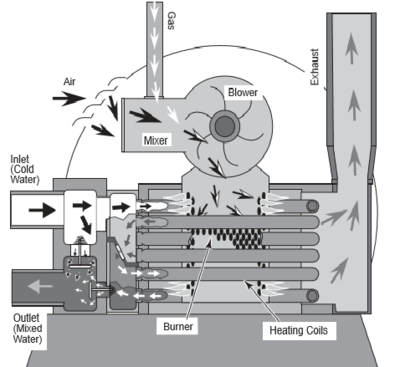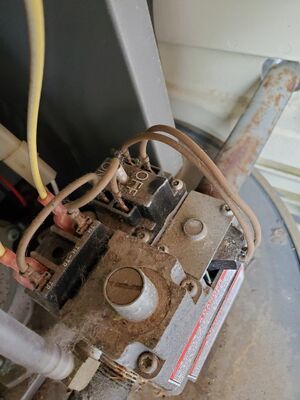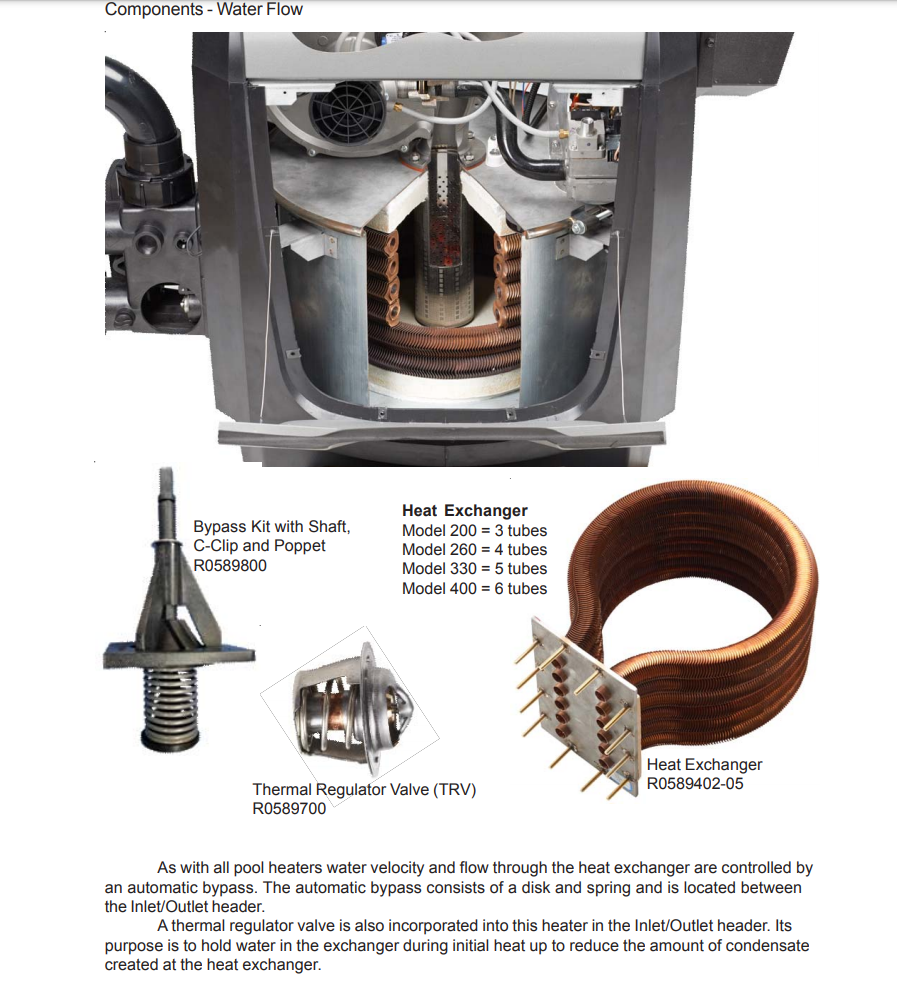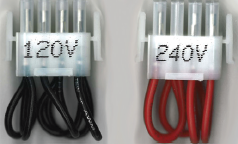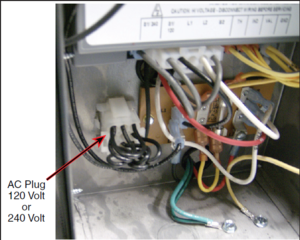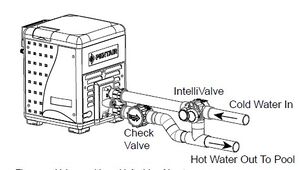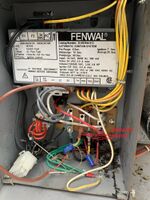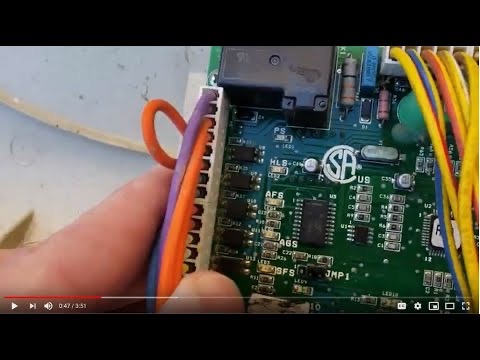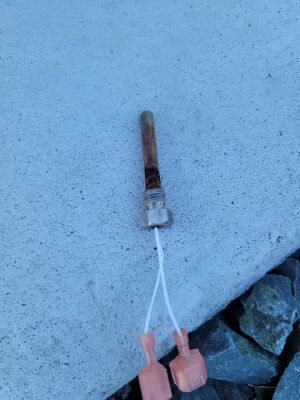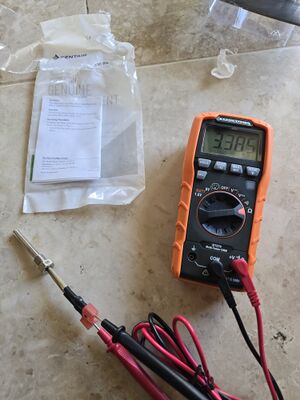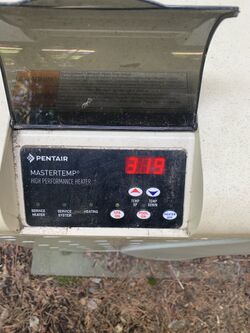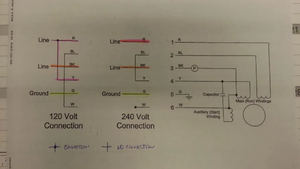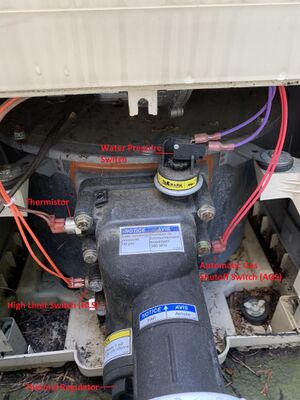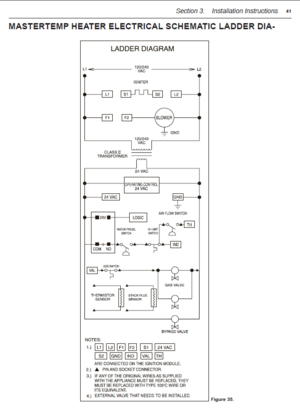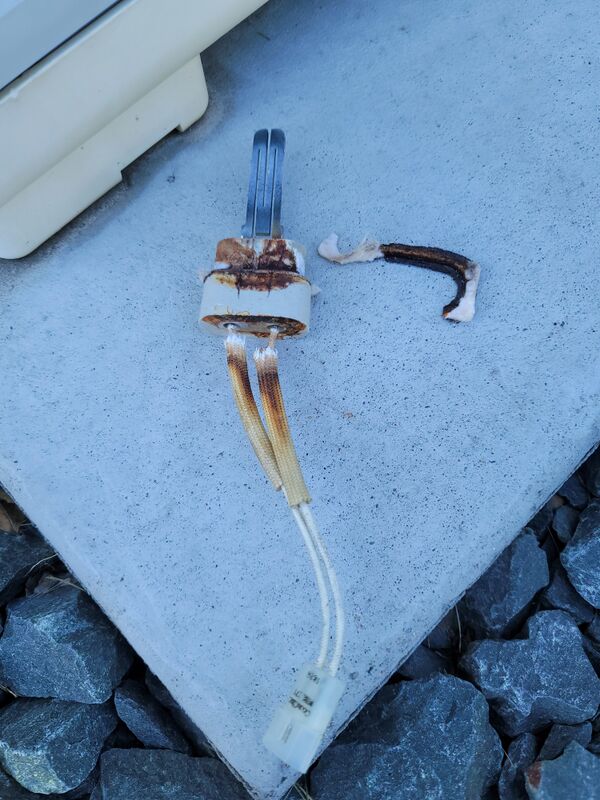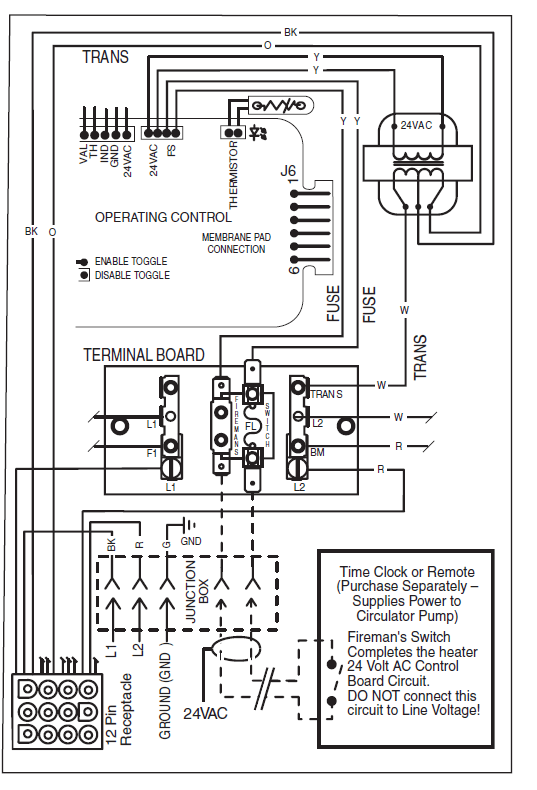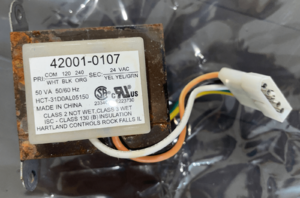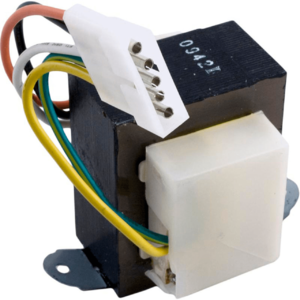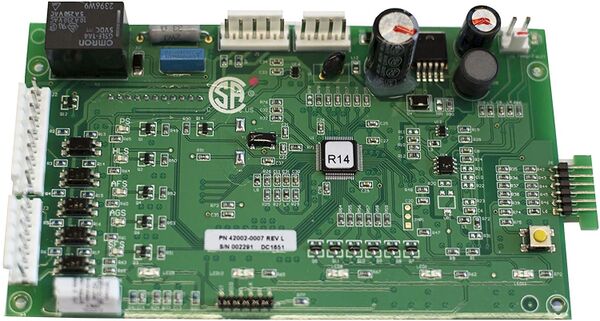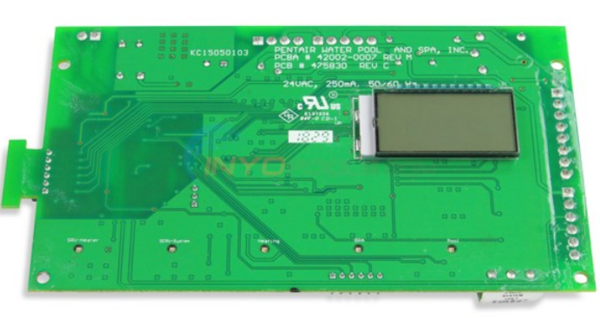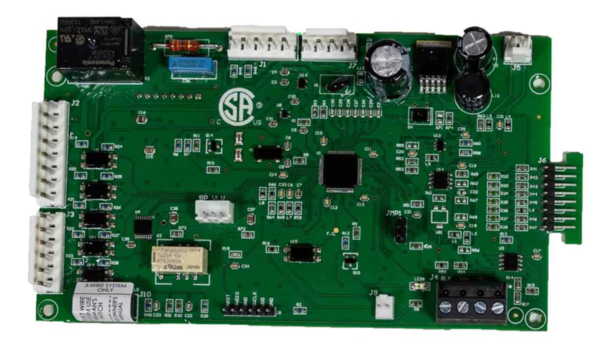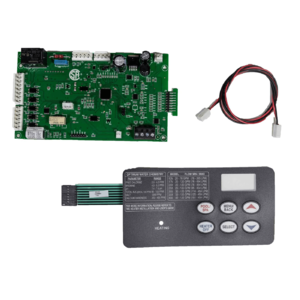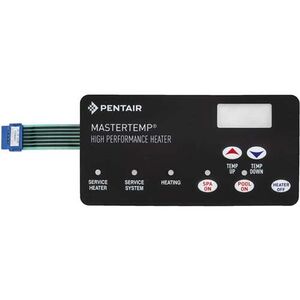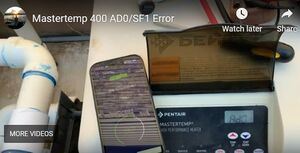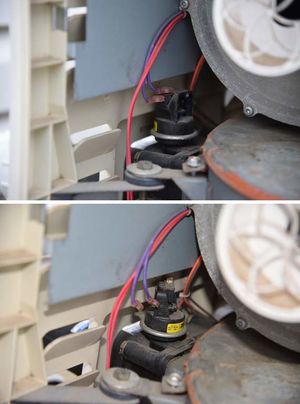| (49 intermediate revisions by the same user not shown) | |||
| Line 20: | Line 20: | ||
The MasterTemp heater is a compact, lightweight, efficient, induced-draft, gas-fired high-performance pool and spa heater that can be directly connected to schedule 40 PVC pipe. The MasterTemp heater also comes equipped with the Pentair multifunction temperature controller, which shows the proper functioning of the heater. All MasterTemp heaters are designed with a direct ignition device, HSI (hot-surface ignition), eliminating the need for a standing pilot. The MasterTemp heater requires an external power source (120/240 VAC 60 Hz) to operate.<ref>https://www.pentair.com/content/dam/extranet/product-related/product-manuals/pool-and-spa-equipment/mastertemp/MasterTemp_Pool_and_Spa_Heater_Installation_and_Users_Guide_English.pdf</ref> | The MasterTemp heater is a compact, lightweight, efficient, induced-draft, gas-fired high-performance pool and spa heater that can be directly connected to schedule 40 PVC pipe. The MasterTemp heater also comes equipped with the Pentair multifunction temperature controller, which shows the proper functioning of the heater. All MasterTemp heaters are designed with a direct ignition device, HSI (hot-surface ignition), eliminating the need for a standing pilot. The MasterTemp heater requires an external power source (120/240 VAC 60 Hz) to operate.<ref>https://www.pentair.com/content/dam/extranet/product-related/product-manuals/pool-and-spa-equipment/mastertemp/MasterTemp_Pool_and_Spa_Heater_Installation_and_Users_Guide_English.pdf</ref> | ||
| − | [https://www.pentair.com/content/dam/extranet/nam/pentair-pool/residential/catalogs/ | + | [https://www.pentair.com/content/dam/extranet/nam/pentair-pool/residential/catalogs/2025-pool-product-catalog/low-resolution-pdfs-for-posting-2025-2026-edition/heaters-heat-pumps-2025-2026/sec06_heaters_2025-2026.pdf 2025-2026 Pentair HEATERS & HEAT PUMPS Catalog] |
| − | [https://www.pentair.com/content/dam/extranet/nam/pentair-pool/residential/catalogs/ | + | [https://www.pentair.com/content/dam/extranet/nam/pentair-pool/residential/catalogs/2025-pool-product-catalog/low-resolution-pdfs-for-posting-2025-2026-edition/heaters-heat-pumps-2025-2026/sec19_rp_heaters_2025-2026.pdf Pentair HEATERS & HEAT PUMPS PARTS Product Catalog 2025-2026] |
===MasterTemp Connected Heater=== | ===MasterTemp Connected Heater=== | ||
| Line 101: | Line 101: | ||
===Sequence of Operation=== | ===Sequence of Operation=== | ||
[[File:Pentair MasterTemp 400 operating pic.png|400px|thumb]] | [[File:Pentair MasterTemp 400 operating pic.png|400px|thumb]] | ||
| − | Normal boot-up is 888, 128, and then | + | Normal boot-up is 888, 128, and then rX, where X is the software revision number. |
Normal boot up for the Connected Heater board with the six-button control panel may just display RX, where X is the software revision number. | Normal boot up for the Connected Heater board with the six-button control panel may just display RX, where X is the software revision number. | ||
| Line 144: | Line 144: | ||
[[File:Pentair MasterTemp Voltage Plug Location.png|thumb]] | [[File:Pentair MasterTemp Voltage Plug Location.png|thumb]] | ||
| − | === | + | ===Plumbing=== |
| − | ====Automatic Heater Bypass==== | + | The standard MasterTemp heater manifold uses a buttress thread (aka., flat thread) on the connector tubes (P/N 77707-0017) for the inlet and outlet that unions are connected to. |
| + | |||
| + | Pentair Mastertemp ASME models with bronze headers and cupro-nickel heat exchanger manifolds are threaded for a "V" type pipe connector (NPT tight thread). To make the connections, a member needed to buy a CPVC (not PVC) single 2" OD x 12"long pipe nipple connector that is NPT threaded on both ends and cut it in half. Then he screwed one of the halves into the threaded pool water inlet and the other half into the outlet and glued the cut ends like regular PVC pipe to the pool piping.<ref>https://www.troublefreepool.com/threads/pentair-pool-heater-astm-thread-vs-buttress-thread.305929/post-2669495</ref> | ||
| + | |||
| + | ====Heater Bypass==== | ||
| + | |||
| + | =====Automatic Heater Bypass===== | ||
The MasterTemp Connected Heaters support an automatic heater bypass using an IntelliValve, or other actuator, connected to the socket labelled BP_VLV on the PCBA in the heater. Pentair has the [https://www.pentair.com/content/dam/extranet/nam/pentair-pool/residential/parts-sheets/heaters/pentair_heater_auto_bypass_valve_replacement%20_kit.pdf AUTOMATIC BY-PASS VALVE KIT (P/N 462048) FOR MASTERTEMP® AND MAX-E-THERM® POOL AND SPA HEATERS] | The MasterTemp Connected Heaters support an automatic heater bypass using an IntelliValve, or other actuator, connected to the socket labelled BP_VLV on the PCBA in the heater. Pentair has the [https://www.pentair.com/content/dam/extranet/nam/pentair-pool/residential/parts-sheets/heaters/pentair_heater_auto_bypass_valve_replacement%20_kit.pdf AUTOMATIC BY-PASS VALVE KIT (P/N 462048) FOR MASTERTEMP® AND MAX-E-THERM® POOL AND SPA HEATERS] | ||
| Line 167: | Line 173: | ||
Members report that the automatic bypass will not "bypass" the heater after the cooldown when the valve is plugged into the heater BP_VLV on the PCBA circuit board. Pentair has been notified of this problem. | Members report that the automatic bypass will not "bypass" the heater after the cooldown when the valve is plugged into the heater BP_VLV on the PCBA circuit board. Pentair has been notified of this problem. | ||
| − | Instead, those with an IntelliCenter have moved the bypass valve actuator wire to the Intellicenter board and tied it into the heater circuit. | + | Instead, those with an IntelliCenter have moved the bypass valve actuator wire to the Intellicenter board and tied it into the heater circuit. The bypass actuator can be plugged into Valve A without a solar valve. The Solar Valve defaults to Valve A, and the heater bypass needs to be plugged into Valve B. |
| + | |||
| + | In the IntelliCenter Setup you need to associate the bypass valve - A or B - with the heater circuit - Heater or MasterTemp. | ||
| − | ====Manual Heater Bypass==== | + | It bypasses immediately when the Intellicenter is no longer calling for heat. The IntelliCenter Users Guide says, "Heaters manufactured by Pentair Water Pool and Spa do not require this cool-down period and do not need the delay to be set up." Additionally, the Pentair Installation Instructions for the Automatic Bypass Valve instructs the bypass valve to be set to not fully close when bypassed. |
| + | |||
| + | =====Manual Heater Bypass===== | ||
A manual [[Heater Bypass|heater bypass]] allows the heater to be taken out of the water loop for maintenance or if there are concerns about the water quality such as low pH that can damage the heat exchanger. | A manual [[Heater Bypass|heater bypass]] allows the heater to be taken out of the water loop for maintenance or if there are concerns about the water quality such as low pH that can damage the heat exchanger. | ||
| Line 187: | Line 197: | ||
Our conclusion is MasterTemp heaters do not require a cool down period. | Our conclusion is MasterTemp heaters do not require a cool down period. | ||
| − | ===Firemans Switch=== | + | ===Automation Control=== |
| + | ====Firemans Switch==== | ||
[[File:Pentair MasterTemp Firemans Switch.jpg|150px|thumb]] | [[File:Pentair MasterTemp Firemans Switch.jpg|150px|thumb]] | ||
The "Fireman's Switch" is a poor name for the 2 wire 24 volt AC remote control system of the heater. The Fireman's Switch is a 2 wire control that can connect to automation such as the EasyTouch or IntelliCenter or to a timer. The current is less than 500 milliamps (0.5 amps). | The "Fireman's Switch" is a poor name for the 2 wire 24 volt AC remote control system of the heater. The Fireman's Switch is a 2 wire control that can connect to automation such as the EasyTouch or IntelliCenter or to a timer. The current is less than 500 milliamps (0.5 amps). | ||
| Line 201: | Line 212: | ||
The blower will continue to run for about 45 seconds after the burner shuts off.<ref>https://www.troublefreepool.com/threads/heater-integration-with-easytouch-and-new-pump.202123/post-1784068</ref> | The blower will continue to run for about 45 seconds after the burner shuts off.<ref>https://www.troublefreepool.com/threads/heater-integration-with-easytouch-and-new-pump.202123/post-1784068</ref> | ||
| − | ===RS-485 Remote Control=== | + | ====RS-485 Remote Control==== |
A running change to all Pentair MasterTemp & StaRite Max E Therm heaters, took place on the afternoon of 5/7/2021. The new version heaters are called Connected Heaters and have the RS-485 comm port and a "6-button" membrane keypad (with a MENU button).<ref>https://www.troublefreepool.com/threads/intellicenter-and-mastertemp-400-communication.209684/post-2073090</ref> | A running change to all Pentair MasterTemp & StaRite Max E Therm heaters, took place on the afternoon of 5/7/2021. The new version heaters are called Connected Heaters and have the RS-485 comm port and a "6-button" membrane keypad (with a MENU button).<ref>https://www.troublefreepool.com/threads/intellicenter-and-mastertemp-400-communication.209684/post-2073090</ref> | ||
| Line 207: | Line 218: | ||
While the manual says the MasterTemp can connect to Pentair control systems via a 3 wire RS-485 connection the connector is not on older boards. See pages 37-40 of the [https://www.pentair.com/content/dam/extranet/pentair-pool/residential/manuals/heaters/mastertemp/Manual-MasterTemp-472592-English.pdf Installation Manual] | While the manual says the MasterTemp can connect to Pentair control systems via a 3 wire RS-485 connection the connector is not on older boards. See pages 37-40 of the [https://www.pentair.com/content/dam/extranet/pentair-pool/residential/manuals/heaters/mastertemp/Manual-MasterTemp-472592-English.pdf Installation Manual] | ||
| − | ====IntelliCenter and RS-485 Heater Control==== | + | =====IntelliCenter and RS-485 Heater Control===== |
The IntelliCenter configuration must be set to the correct control interface: | The IntelliCenter configuration must be set to the correct control interface: | ||
| Line 220: | Line 231: | ||
With the RS-485 connection the IntelliCenter tells the MasterTemp heater if it should be active, the desired heat setpoint, and if the POOL or SPA is being heated. The Connected MasterTemp then is the thermostat and cycles as necessary to maintain the heat setpoint. The heat setpoint is displayed on both the IntelliCenter displays and the MasterTemp LCD display.<ref>https://www.troublefreepool.com/threads/mastertemp-400-control-point-issue-intellicenter-control.270977/post-2376164</ref> | With the RS-485 connection the IntelliCenter tells the MasterTemp heater if it should be active, the desired heat setpoint, and if the POOL or SPA is being heated. The Connected MasterTemp then is the thermostat and cycles as necessary to maintain the heat setpoint. The heat setpoint is displayed on both the IntelliCenter displays and the MasterTemp LCD display.<ref>https://www.troublefreepool.com/threads/mastertemp-400-control-point-issue-intellicenter-control.270977/post-2376164</ref> | ||
| − | ====MasterTemp RS-485 Combo Conversion/Replacement Kit==== | + | =====MasterTemp RS-485 Combo Conversion/Replacement Kit===== |
[https://www.pentair.com/content/dam/extranet/nam/pentair-pool/residential/parts-sheets/heaters/pentair_heater_rs485_combo_conversion_replacement%20_kit.pdf RS-485 COMBO CONVERSION REPLACEMENT KIT USA (P/N 476211) AND AUSTRALIA (P/N 462049) FOR MASTERTEMP® AND MAX-E-THERM® POOL AND SPA HEATERS] | [https://www.pentair.com/content/dam/extranet/nam/pentair-pool/residential/parts-sheets/heaters/pentair_heater_rs485_combo_conversion_replacement%20_kit.pdf RS-485 COMBO CONVERSION REPLACEMENT KIT USA (P/N 476211) AND AUSTRALIA (P/N 462049) FOR MASTERTEMP® AND MAX-E-THERM® POOL AND SPA HEATERS] | ||
| Line 240: | Line 251: | ||
Theoretically, you could today order part #1 & #2 & #3 & #4 individually (you would order four separate part numbers and get four separate boxes) and accomplish the same thing, but Pentair expects very few people to go through the trouble of taking apart an older heater to install all four parts just for the sake of doing an elective upgrade, which is why the four part kit/bundle remains unreleased. | Theoretically, you could today order part #1 & #2 & #3 & #4 individually (you would order four separate part numbers and get four separate boxes) and accomplish the same thing, but Pentair expects very few people to go through the trouble of taking apart an older heater to install all four parts just for the sake of doing an elective upgrade, which is why the four part kit/bundle remains unreleased. | ||
| − | ====Displaying the MasterTemp PCB Version==== | + | =====Displaying the MasterTemp PCB Version===== |
To display the Version for a MasterTemp that is connected to the IntelliCenter with the RS485 connection:<ref> https://www.troublefreepool.com/threads/intellicenter-and-mastertemp-400-communication.209684/post-2376610 </ref> | To display the Version for a MasterTemp that is connected to the IntelliCenter with the RS485 connection:<ref> https://www.troublefreepool.com/threads/intellicenter-and-mastertemp-400-communication.209684/post-2376610 </ref> | ||
| Line 319: | Line 330: | ||
The HLS is often caused by insufficient water flow through the heat exchanger. This can be due to several things: | The HLS is often caused by insufficient water flow through the heat exchanger. This can be due to several things: | ||
| − | *Thermal regulator not opening. | + | *[[Pentair_MasterTemp_Heaters#Thermal_Regulator|Thermal regulator]] not opening. |
*External bypass open. | *External bypass open. | ||
| − | *Internal bypass broken. | + | *[[Pentair_MasterTemp_Heaters#Bypass_Valve|Internal bypass]] broken. |
*Pump too small or on too low rpm. | *Pump too small or on too low rpm. | ||
*Clogged filter. | *Clogged filter. | ||
| Line 543: | Line 554: | ||
We have also seen quality control issues with claimed genuine Pentair thermal regulators that did not open at 120F. It is best to test any thermal regulator before installing it and return it if it does not open at 120F as stamped on its face. | We have also seen quality control issues with claimed genuine Pentair thermal regulators that did not open at 120F. It is best to test any thermal regulator before installing it and return it if it does not open at 120F as stamped on its face. | ||
| + | |||
| + | Thermal regulator part number is 38000-0007 | ||
| + | |||
| + | Thermal Regulator kit with regulator, spring and cap is 77707-0010 | ||
| + | |||
| + | You can usually find the kit for about the same price as the thermal regulator alone. | ||
===Bypass Valve=== | ===Bypass Valve=== | ||
[[File:Pentair MasterTemp Bypass Valve.jpg|100px|thumb|Bypass Valve]] | [[File:Pentair MasterTemp Bypass Valve.jpg|100px|thumb|Bypass Valve]] | ||
| − | If the bypass valve is broken the heater will short cycle and/or make noise. If you look in the hole where the thermal regulator goes, you should be able to see the black disk. If you look in the water inlet, you should be able to see the spring. | + | If the bypass valve is broken, the heater will short cycle and/or make noise. If you look in the hole where the thermal regulator goes, you should be able to see the black disk. If you look in the water inlet, you should be able to see the spring. |
| − | The bypass valve is spring-loaded to allow "just enough" water into and through the heat exchanger | + | The bypass valve is spring-loaded to allow "just enough" water into and through the heat exchanger for the best heat transfer. It then mixes with the water that is being bypassed, and the water entering the pool/spa should be about 6 degrees hotter than the body of water.<ref> https://www.troublefreepool.com/threads/pentair-mastertemp-400hd-manifold-design-operation.287098/post-2518192 </ref> |
| − | If the bypass valve fails too little water goes into the heat exchanger and comes out too hot. That causes the HLS or AGS to open so that the water entering the pool will not burn someone. So little water can enter the exchanger that it will flash boil and you get a loud knocking noise with even the whole heater bouncing due to the steam pressure of the boiling water. | + | If the bypass valve fails, too little water goes into the heat exchanger and comes out too hot. That causes the HLS or AGS to open so that the water entering the pool will not burn someone. So little water can enter the exchanger that it will flash boil and you get a loud knocking noise with even the whole heater bouncing due to the steam pressure of the boiling water. |
| − | + | The manifold must be removed to replace the Internal by-pass kit P/N 77707-0001. If you remove the manifold read the [https://www.troublefreepool.com/attachments/maxetherm-heater-manifold-replacement-manual-english-1-pdf.640226 Heater Manifold Replacement Instructions] on how to reinstall the manifold, the bolt tightening sequence, and torque requirements. | |
[[File:Pentair MasterTemp Manifold with Bypass Valve.png|thumb]] | [[File:Pentair MasterTemp Manifold with Bypass Valve.png|thumb]] | ||
| Line 558: | Line 575: | ||
[https://www.troublefreepool.com/threads/mastertemp-bypass-valve.41000/post-346256 Guide to replacing the bypass valve] is for the residential MasterTemp model. | [https://www.troublefreepool.com/threads/mastertemp-bypass-valve.41000/post-346256 Guide to replacing the bypass valve] is for the residential MasterTemp model. | ||
| − | The ASME commercial MasterTemp model has a different manifold with a 2-inch Pipe Plug | + | The ASME commercial MasterTemp model has a different manifold with a 2-inch Pipe Plug (for access to Internal BypassValve) located at the top of the Manifold.<ref>https://www.pentair.com/content/dam/extranet/product-related/product-manuals/pool-and-spa-equipment/mastertemp/MasterTemp_and_Max-E-Therm_Bypass_Access_Plug_Kit_Instructions_ASME_Models_Only_English.pdf</ref> |
| + | |||
| + | ===MasterTemp/Maxetherm Manifold Replacement=== | ||
| + | |||
| + | The [https://www.troublefreepool.com/attachments/maxetherm-heater-manifold-replacement-manual-english-1-pdf.640226/ HEATER MANIFOLD REPLACEMENT INSTRUCTIONS] describe the process for removing and replacing the manifold. | ||
| + | |||
| + | The manifold bolts can be difficult to remove. Liberally soaking them in a penetrating oil can help loosen them and prevent snapping off a bolt head. | ||
| + | |||
| + | [[File:Penetrating Oils Compared.png|thumb]] | ||
| + | |||
| + | Before installing the manifold clean the tube sheet and O-ring sealing surface with a nylon brush, then brighten the tube sheet surface with 320 grit emery cloth. When cleaning, be careful not to push the tube sheet into the combustion chamber. If you do, thread a couple of bolts into it and pull it back in place. | ||
| + | |||
| + | Then brush off all dust and debris with a brush and wipe it down with a cloth. And apply the supplied silicone grease to the O-Rings. Install the O-rings on tube ends before installing the manifold. | ||
| + | |||
| + | Install and hand tighten the bolts. Then install the Thermal Regulator in the Manifold. | ||
| + | |||
| + | Follow the torque pattern in the manual to tighten the bolts. Some noise (pop- ping, etc.) is normal as you tighten. Go around the manifold and retighten the bolts as needed to 75-115 in.-lbs. (8.4-12.9 N-m) (you may have to do this several times). | ||
| + | |||
| + | [[File:Pentair MasterTemp Manifold Bolt Sequence.png|thumb]] | ||
| + | |||
| + | Start and run the filter pump for several minutes before starting the heater in order to purge all air from the system. Open all air vents in the system (on Filter, Strainer, etc.) while purging the air. Run the pump with the vents open until all vents run a solid stream of water. | ||
===Bad Temperature Sensor=== | ===Bad Temperature Sensor=== | ||
[[File:Pentair MasterTemp Water Manifold.jpg|thumb]] | [[File:Pentair MasterTemp Water Manifold.jpg|thumb]] | ||
| − | * The "E01" code | + | * The "E01" code indicates an open water temperature sensor, also called the thermistor on the parts diagram. |
| − | *Problem - Heat will not fire, blower does not even turn... heat is set at 89*. membrane is showing water temp 107... easy touch panel temp reading is accurate (thermometer in pool 83*).<ref>https://www.troublefreepool.com/threads/mastertemp-400-ng-bad-board.192416/</ref> | + | *Problem - Heat will not fire, blower does not even turn... heat is set at 89*. the membrane is showing water temp 107.... The easy touch panel temp reading is accurate (thermometer in pool 83*).<ref>https://www.troublefreepool.com/threads/mastertemp-400-ng-bad-board.192416/</ref> |
*Thermistor p/n 42001-0053S Part 7 on page 54 of the MasterTemp Installation manual<ref>https://www.pentair.com/content/dam/extranet/pentair-pool/commercial/manuals/heaters/Manual-MasterTemp-472592-English.pdf</ref>. | *Thermistor p/n 42001-0053S Part 7 on page 54 of the MasterTemp Installation manual<ref>https://www.pentair.com/content/dam/extranet/pentair-pool/commercial/manuals/heaters/Manual-MasterTemp-472592-English.pdf</ref>. | ||
| + | |||
| + | [[File:Pentair MasterTemp Thermistor Temperature Sensor.jpg|thumb]] | ||
| + | |||
| + | [[Temperature Sensors]] describe how to test a thermistor using a multimeter. | ||
===Blower not Operating=== | ===Blower not Operating=== | ||
| − | Listen closely when you turn the heater on | + | Listen closely when you turn the heater on after it cycles through the 888, 128, and R13. You may need to put your ear right next to the top of the heater (where the board is) to hear if the small relay on the Fenwal box clicks (May sound more like a "tick" than a "click"), giving voltage to the blower. This click will be more subtle than the click you normally hear when the gas valve opens (you won't hear that one, though, if the blower never starts).<ref>https://www.troublefreepool.com/threads/mastertemp-400-issue.151028/post-1341812</ref> |
| − | If you can hear the click, look at the blower. | + | If you can hear the click, look at the blower. If there is no click, look at the Fenwal box. If you are getting the AFS error, the safety switches have been satisfied, and the board should tell the Fenwal module to begin the ignition process. |
| − | Another reason the AFS error is thrown is | + | Another reason the AFS error is thrown is that the airflow switch (AFS) is closed before the blower starts. The Fenwal checks that the AFS is open before it begins the ignition sequence. If the AFS is closed, then the AFS is shown. |
The blower is powered through the Fenwal F1/F2 connections that are a relay. | The blower is powered through the Fenwal F1/F2 connections that are a relay. | ||
| − | The F1/F2 relay contacts in the Fenwal | + | The F1/F2 relay contacts in the Fenwal should close and start the blower motor when you have 24 volts between "IND" and the 24-volt ground. If you have 24 volts at these 2 points and the F1/F2 contacts do not close, you would need to replace the Fenwal. |
Check for 24V between IND and ground when the heater starts up. | Check for 24V between IND and ground when the heater starts up. | ||
| − | The ladder diagram shows that once 24V is on IND and the Fenwal closes the relay to power the blower through F1/F2 it expects the AFS to close putting 24V on TH which tells the Fenwal to begin the ignition sequence with the igniter and gas valve. | + | The ladder diagram shows that once 24V is on IND and the Fenwal closes the relay to power the blower through F1/F2, it expects the AFS to close, putting 24V on TH, which tells the Fenwal to begin the ignition sequence with the igniter and gas valve. |
[[File:Pentair MasterTemp Ladder Diagram.png|thumb]] | [[File:Pentair MasterTemp Ladder Diagram.png|thumb]] | ||
| − | If you have a multimeter | + | If you have a multimeter, disconnect the wires to the Fenwal F1 and F2 and safe them off. Check if there is no continuity between F1 and F2 when the heater is off and that there is continuity when you start the heater. That would show whether the relay in the Fenwal is working or not. |
Check if you get voltage at F2 when the heater starts up. If you do not have voltage at F2 and have voltage at F1 then the FENWAL may be bad. The F1/F2 contacts on the Fenwal are supposed to close and start the blower motor when you have 24 volts between "IND" and the 24 volt ground. If you have 24 volts at these 2 points and the contacts do not close, you would need to replace the Fenwal. | Check if you get voltage at F2 when the heater starts up. If you do not have voltage at F2 and have voltage at F1 then the FENWAL may be bad. The F1/F2 contacts on the Fenwal are supposed to close and start the blower motor when you have 24 volts between "IND" and the 24 volt ground. If you have 24 volts at these 2 points and the contacts do not close, you would need to replace the Fenwal. | ||
| − | If you have voltage at F2 and the blower does not run | + | If you have voltage at F2 and the blower does not run, you may have a problem with the blower motor. |
| − | You can jumper F1 and F2 together bypassing the Fenwal relay and the blower motor should run when the heater is powered on. That confirms the blower motor works. | + | You can jumper F1 and F2 together, bypassing the Fenwal relay, and the blower motor should run when the heater is powered on. That confirms that the blower motor works. |
===Blower Continues Running When Heater is Powered=== | ===Blower Continues Running When Heater is Powered=== | ||
| Line 599: | Line 640: | ||
===Bad Igniter=== | ===Bad Igniter=== | ||
| − | If the blower starts, the attempt to light the flame starts, you smell gas, | + | If you bought a MasterTemp heater manufactured in the Fall of 2024 and it is burning up igniters then read [https://www.troublefreepool.com/threads/brand-new-max-e-therm-burning-through-igniters-literally.307587/ Brand New Max e Therm burning through igniters literally] This manufacturing defect was fixed by the end of 2024. |
| + | |||
| + | If the blower starts, the attempt to light the flame starts, you smell gas, hear the click, and then it sounds like something closes. The start sequence will repeat a couple of times and throw the three blinks of the LED on the Fenwal box. Then, you may have a bad igniter. | ||
| − | With a bad igniter you do not hear the woosh of the flame lighting and feel a burst of hot exhaust before it shuts down. | + | With a bad igniter, you do not hear the woosh of the flame lighting and feel a burst of hot exhaust before it shuts down. |
| − | You can | + | You can perform some diagnostics on it to see if it is heating, examine it visually, check its resistance, which should be 50 ohms, and check that 120V AC is going to the igniter when the heater starts. |
A new igniter resistance is 50 ohms. | A new igniter resistance is 50 ohms. | ||
| − | Below is an igniter | + | The igniter is about 450 watts, which is about 3.75 amps at 120 volts. |
| + | |||
| + | Below is an igniter removed from a MasterTemp heater where the flame would light but then shut down due to a [[Heater Flame Sensing|flame sense error]]. | ||
| − | + | Interestingly, the igniter corrosion also occasionally caused the GFCI CB to trip when the heater lit. | |
[[File:Penatir MasterTemp Corroded Igniter.jpg|600px|frameless]] | [[File:Penatir MasterTemp Corroded Igniter.jpg|600px|frameless]] | ||
| Line 617: | Line 662: | ||
After the gas valve opens, the HSI (Hot Surface Ignitor) will switch to a sensing mode to monitor the flame. | After the gas valve opens, the HSI (Hot Surface Ignitor) will switch to a sensing mode to monitor the flame. | ||
| − | When the HSI switches to flame sensing mode, it | + | When the HSI switches to flame sensing mode, it looks for a microamp current in the 1 to 10 microamp range (1.0 to 10 µA). |
| − | If the flame sensor does not read at least 1.0 microamps, the Fenwal controller will shut down | + | If the flame sensor does not read at least 1.0 microamps, the Fenwal controller will shut down the gas valve's power. |
| − | Does the | + | Does the heater briefly ignite, producing a puff of heat before shutting down? If so, you may have a flame-sensing problem. [[Heater Flame Sensing]] describes what may be happening and offers ways to fix it. |
===24V AC Fuse Blows=== | ===24V AC Fuse Blows=== | ||
| − | You can try removing the operating control board connectors at J1, J2 and J3 leaving only the 24V input to the control board and the | + | You can try removing the operating control board connectors at J1, J2, and J3, leaving only the 24V input to the control board and the fireman's switch return to the control board at J7. Does the fuse blow? If so, you have isolated the problem to the fireman's switch, its wiring, or the control board. If it doesn't blow, attach the connector at J1 and repower the heater. Does the fuse blow? If so, you have isolated the problem to the ICM or its associated wiring. The only connection at the ICM with zero or near zero ohms to ground should be the one labeled GND. |
| − | If the fuse blows with only the J7 connector in place, you can remove the J7 connector and check for continuity to ground on the 2 connections associated with the firemans switch. | + | If the fuse blows with only the J7 connector in place, you can remove the J7 connector and check for continuity to ground on the 2 connections associated with the firemans switch. You have a problem with the control board if they read as open. |
The fuse for the Fireman’s Switch is a 1.25 Amp 1¼ x ¼” fast blow fuse, which is commonly available. | The fuse for the Fireman’s Switch is a 1.25 Amp 1¼ x ¼” fast blow fuse, which is commonly available. | ||
| Line 634: | Line 679: | ||
Wiring can get chewed up by critters. | Wiring can get chewed up by critters. | ||
| + | <gallery> | ||
| + | File:Pentair MasterTemp Chewed Wires 1.jpg | ||
| + | File:Pentair MasterTemp Chewed Wires 2.jpg | ||
| + | </gallery> | ||
| − | + | Pentair says: | |
| − | + | ''If any original wiring supplied with this heater must be replaced, the installer must supply (No. 18 AWG, 600V, 105° C. U.L. approved AWM low-energy stranded) copper wire or its equivalent.'' | |
| − | + | ''Line voltage field wiring should be 14 gauge, with a circuit capacity of 15 Amps.'' | |
| + | |||
| + | ''The old non-connected heater's complete replacement wiring harness (p/n 42001-0104S) is being replaced by the replacement wiring harness for the Connected Heater (p/n 461107). The new Wiring Harness for the Connected Heater has adapters to make it backward compatible with the non-connected heater.'' | ||
===Replacing Transformer=== | ===Replacing Transformer=== | ||
| Line 647: | Line 698: | ||
A bad transformer can cause the fuse to blow. | A bad transformer can cause the fuse to blow. | ||
| − | If the MasterTemp heater display does not light up when heat is commanded then check the power beginning at the Circuit Breaker. Use a multimeter and starting with the CB powering the heater check for voltage coming into the heater 12 pin receptacle. Confirm the correct voltage receptacle is installed and secure. | + | If the MasterTemp heater display does not light up when heat is commanded, then check the power, beginning at the Circuit Breaker. Use a multimeter, and starting with the CB powering the heater, check for voltage coming into the heater's 12-pin receptacle. Confirm that the correct voltage receptacle is installed and secure. |
| − | + | The diagram below shows that the high voltage goes directly to the transformer, which lowers it to 24V AC. Check for the 24V AC at the transformer and at the 24V AC plug into the main board. | |
| − | + | The heater display should light up if you have 24V AC at the PCB. | |
[[File:Pentair MaserTemp Electrical Diagram.png|600px|frameless]] | [[File:Pentair MaserTemp Electrical Diagram.png|600px|frameless]] | ||
| Line 659: | Line 710: | ||
===Main Board=== | ===Main Board=== | ||
| − | Control Board Kit (NA, LP Series) | + | The part number of the Control Board Kit (NA, LP Series) is 42002-0007S. |
[[File:Pentair 42002-0007S Control Board Kit.jpg|600px|frameless|Old Control Board]] | [[File:Pentair 42002-0007S Control Board Kit.jpg|600px|frameless|Old Control Board]] | ||
| Line 665: | Line 716: | ||
[[File:Pentair MasterTemp PCB Display side.png|600px|frameless]] | [[File:Pentair MasterTemp PCB Display side.png|600px|frameless]] | ||
| − | The | + | The new Connected Heater control board is replacing the old control board p/n 461105. The new |
| − | Control Board Kit 461105 comes with "6 button" membrane keypad. When replacing a control board on an | + | Control Board Kit 461105 comes with a "6 button" membrane keypad. When replacing a control board on an |
| − | older heater | + | older heater with a 5-button keypad, you will also need to update the heater to have the 6-button keypad. |
[[File:Pentair MasterTemp New Connected Control Board.png|600px|frameless|New Control Board]] | [[File:Pentair MasterTemp New Connected Control Board.png|600px|frameless|New Control Board]] | ||
| Line 673: | Line 724: | ||
See the [https://www.pentair.com/content/dam/extranet/nam/pentair-pool/residential/parts-sheets/heaters/mastertemp-max-e-therm-parts-matrix-connected-heater-update-v1.pdf Pentair MasterTemp & StaRite Max E Therm : Parts Matrix for “Connected Heater” Update May 2021]. | See the [https://www.pentair.com/content/dam/extranet/nam/pentair-pool/residential/parts-sheets/heaters/mastertemp-max-e-therm-parts-matrix-connected-heater-update-v1.pdf Pentair MasterTemp & StaRite Max E Therm : Parts Matrix for “Connected Heater” Update May 2021]. | ||
| − | The new control board comes in a kit with the required six button keypad and a red/black "flame" cable. | + | The new control board comes in a kit with the required six-button keypad and a red/black "flame" cable. |
[[File:Pentair MasterTemp 461105 Kit.png|thumb]] | [[File:Pentair MasterTemp 461105 Kit.png|thumb]] | ||
| Line 681: | Line 732: | ||
====Beware of Non-Pentair Boards==== | ====Beware of Non-Pentair Boards==== | ||
| − | Control Boards for the MasterTemp are being sold on eBay and Amazon | + | Control Boards for the MasterTemp that are not Pentair OEM are being sold on eBay and Amazon. Some are from Swimables. We have had two reports, [https://www.troublefreepool.com/threads/help-pentair-mastertemp-250-not-connected-to-easytouch-and-now-wont-start.269240/post-2359617 here] and [https://www.troublefreepool.com/threads/mastertemp-400-not-firing.270341/post-2370001 here], of these boards not working. |
| − | The clone boards have very different components and lack all the Pentair labeling | + | The clone boards have very different components and lack all the Pentair labeling. |
=== Pentair Membrane Key Pad Replacement=== | === Pentair Membrane Key Pad Replacement=== | ||
| − | The membrane keypad sometimes fails and is separately replaceable with Pentair part number 472610Z for the five button keypad used on the non-connected heater version. | + | The membrane keypad sometimes fails, and it is separately replaceable with Pentair part number 472610Z for the five-button keypad used on the non-connected heater version. |
[[File:Pentair MasterTemp Keypad 472610Z.jpg|thumb]] | [[File:Pentair MasterTemp Keypad 472610Z.jpg|thumb]] | ||
| − | The Connected Heater version uses a six button keypad with a MENU button. | + | The Connected Heater version uses a six-button keypad with a MENU button. |
| − | When replacing a control board on an older heater | + | When replacing a control board on an older heater with a 5-button keypad, you will also need to update the heater to have a 6-button keypad. |
[[File:Pentair MasterTemp Keypads.jpg|600px|frameless]] | [[File:Pentair MasterTemp Keypads.jpg|600px|frameless]] | ||
| − | To replace the membrane keypad peel the old one off, clean the area as best you can, stick on the new keypad. Be sure to align the openings for the service lights. Also, push the ribbon cable all the way through before removing the protective paper or it can get stuck to the membrane. | + | To replace the membrane keypad, peel the old one off, clean the area as best you can, and stick it on the new keypad. Be sure to align the openings for the service lights. Also, push the ribbon cable all the way through before removing the protective paper, or it can get stuck to the membrane. |
| − | If a single button on the keypad is not working it may be due to corrosion on the pins of the membrane keypad ribbon cable. Cleaning any dark pins with emery cloth may get the keypad working.<ref>https://www.troublefreepool.com/threads/pentair-mastertemp-250-up-button-wont-work.293182/post-2574217</ref> | + | If a single button on the keypad is not working, it may be due to corrosion on the pins of the membrane keypad ribbon cable. Cleaning any dark pins with emery cloth may get the keypad working.<ref>https://www.troublefreepool.com/threads/pentair-mastertemp-250-up-button-wont-work.293182/post-2574217</ref> |
| − | The following applies to the | + | The following applies to the five-button keypads on the older MasterTemp heaters. Pin 1 is the common wire. Shorting pins 1 to 2 briefly is the same as pressing "Spa On." Pressing a button on the membrane pad shorts a pin (2 through 5) to pin 1 to make a selection. Pin 1 is the lowest pin, and pin 6 is the highest pin.<ref>https://www.troublefreepool.com/threads/pentair-mastertemp-250-up-button-wont-work.293182/post-2574224</ref> |
*1 to 2 ...spa on. | *1 to 2 ...spa on. | ||
| Line 710: | Line 761: | ||
[[File:Pentair MasterTemp Board Keypad Pins Numbered.png|thumb]] | [[File:Pentair MasterTemp Board Keypad Pins Numbered.png|thumb]] | ||
| − | You can briefly | + | You can briefly jump the pins as listed above to simulate pressing a button but don't leave them shorted. |
| − | The pins are so small and close together that | + | The pins are so small and close together that jumping any two without touching the others is hard. So don't do it if you can't short only two. |
| − | If you can short only a single pin to pin one, the board should respond as indicated. If it doesn't, then the control board is bad. | + | If you can short only a single pin to pin one, the board should respond as indicated. If it doesn't, then the control board is bad. The membrane is bad if all pin combinations work by jumping pins but not when pressing the pad buttons. |
===Stack Flue Sensor=== | ===Stack Flue Sensor=== | ||
| − | The part number for the Stack Flue Sensor is Pentair 42002-0024S. The generic ones found on Amazon for about $15.00 seem to work as | + | The part number for the Stack Flue Sensor is Pentair 42002-0024S. The generic ones found on Amazon for about $15.00 seem to work, as does the Pentair $150 sensor. |
[[File:Pentair MasterTemp Stack Flue Sensor.jpg|thumb]] | [[File:Pentair MasterTemp Stack Flue Sensor.jpg|thumb]] | ||
| Line 733: | Line 784: | ||
===Stack Flue Sensor Control Board Setup=== | ===Stack Flue Sensor Control Board Setup=== | ||
| − | The Control Board is designed to work with | + | The Control Board is designed to work with the Stack Flue Switch (on older heaters) and the Stack Flue Sensor (on newer heaters). Please see [https://www.pentair.com/content/dam/extranet/nam/industrial-flow-technologies/flow/ift-asset-library/pool-spa/S381(11-16-04).pdf Figure 2] to identify which type of Stack Flue protection you are replacing. |
| − | If you | + | If you replace a failed Stack Flue Sensor, your Control Board should be set correctly for the new one. However, if you are replacing either an Outdoor Stack Flue Switch or an Indoor Stack Flue Switch, the Control Board will need to be reset as follows: |
#Turn the power to the heater ON. | #Turn the power to the heater ON. | ||
#Press and hold the OFF button on the membrane pad until the 3-digit display shows “Ad0” or “Ad1” (about 10 seconds). | #Press and hold the OFF button on the membrane pad until the 3-digit display shows “Ad0” or “Ad1” (about 10 seconds). | ||
| − | #Release the button and then press it momentarily. The 3-digit display will now show | + | #Release the button and then press it momentarily. The 3-digit display will now show “SF0” or “SF1”. |
#If the display reads “SF1”, it is correctly set. Go to Step 5. If it reads “SF0”, use the arrow buttons on the membrane pad to set it to read “SF1”. | #If the display reads “SF1”, it is correctly set. Go to Step 5. If it reads “SF0”, use the arrow buttons on the membrane pad to set it to read “SF1”. | ||
#Momentarily press the “OFF” button to exit the program. | #Momentarily press the “OFF” button to exit the program. | ||
| − | If at startup the heater is displaying Ad0 and SF1 then the OFF button is stuck. Replace the keypad.<ref>https://www.troublefreepool.com/threads/mastertemp-400-control-board.264185/post-2316544</ref> | + | If, at startup, the heater is displaying Ad0 and SF1, then the OFF button is stuck. Replace the keypad.<ref>https://www.troublefreepool.com/threads/mastertemp-400-control-board.264185/post-2316544</ref> |
[[File:Pentair MasterTemp Ad0.jpg|thumb]] | [[File:Pentair MasterTemp Ad0.jpg|thumb]] | ||
| Line 755: | Line 806: | ||
===AGS Sensors=== | ===AGS Sensors=== | ||
| − | The AGS sensor is just a switch that is either open or closed. They are simple devices and rarely fail. Unless your old one was corroded it is probably still good and | + | The AGS sensor is just a switch that is either open or closed. They are simple devices and rarely fail. Unless your old one was corroded, it is probably still good and doing its job. Confirm, using a multimeter, that the AGS sensor is open when the heater is off before replacing it. |
The AGS trips (opens) when the internal water temperature exiting the heat exchanger is 140 or more. It is a backup to the high-limit switch which is set to open at 135. This is usually caused by too low a flow rate. Possibly a bad internal bypass or thermal regulator as discussed in the sections above. | The AGS trips (opens) when the internal water temperature exiting the heat exchanger is 140 or more. It is a backup to the high-limit switch which is set to open at 135. This is usually caused by too low a flow rate. Possibly a bad internal bypass or thermal regulator as discussed in the sections above. | ||
| − | If you do replace the AGS Sensor use a bit of Teflon tape to | + | If you do replace the AGS Sensor, use a bit of Teflon tape to prevent leaks. It doesn't matter which wire goes to which terminal on the sensor. |
===MasterTemp Unions=== | ===MasterTemp Unions=== | ||
| Line 773: | Line 824: | ||
They are used on: | They are used on: | ||
*Max-E-Therm, MasterTemp heaters | *Max-E-Therm, MasterTemp heaters | ||
| + | *ETI heaters | ||
*Max-E-Pro, Dyna-Pro Pumps | *Max-E-Pro, Dyna-Pro Pumps | ||
*Dyna-Glas/Dyna-Max Series | *Dyna-Glas/Dyna-Max Series | ||
| Line 781: | Line 833: | ||
===Removing Water Pressure Switch=== | ===Removing Water Pressure Switch=== | ||
[[File:Pentair MasterTemp Water Pressure Switch.jpg|thumb]] | [[File:Pentair MasterTemp Water Pressure Switch.jpg|thumb]] | ||
| − | One of the winterizing steps | + | One of the manual's winterizing steps is removing the water pressure switch.<ref> https://www.troublefreepool.com/threads/water-pressure-switch-removal-pentair-heater.153252/post-1355449</ref> |
| − | + | Remove the two panels to access the heater and locate the water pressure switch. Disconnect the two electrical leads and rotate the switch counterclockwise. | |
| − | You may find the switch terminals hit the frame | + | You may find the switch terminals hit the frame, which is the main body panel of the heater. You have to remove the side panel as well. The panel does come off. |
===Air Intake=== | ===Air Intake=== | ||
| Line 792: | Line 844: | ||
==Rat Proofing the Heater== | ==Rat Proofing the Heater== | ||
| − | + | Over the winter, rats climb through the air vents and nest in the heaters. They make a mess inside the heater and damage it by chewing on the wiring and corroding it with their urine. | |
Rats and mice often make their home in the electrical box and chew up the wiring. You can repair the wire harness from any chewed damage. | Rats and mice often make their home in the electrical box and chew up the wiring. You can repair the wire harness from any chewed damage. | ||
| − | You should check the blower rotates freely | + | You should check that the blower rotates freely. You may need to remove the blower motor and clean it out. |
| − | You may need to take the heater apart and clean the combustion chamber, which is a huge job | + | You may need to take the heater apart and clean the combustion chamber, which is a huge job. You may find the mice have made nests inside the heater, which messes up the ignition and the airflow. |
| − | [https://mkratproofing.com/ MK Rat Proofing] sells wire mesh kits to cover the vents or you can fabricate your own using 1/4" mesh wire screen | + | [https://mkratproofing.com/ MK Rat Proofing] sells wire mesh kits to cover the vents, or you can fabricate your own using 1/4" mesh wire screen, simple chicken wire, and some sheet metal. Get the correct kit for the model heater you have. There is an old model with more vents and almond sides and a new model with fewer vents and black sides. |
Some people put mothballs inside the unit to keep mice out. | Some people put mothballs inside the unit to keep mice out. | ||
==Tips== | ==Tips== | ||
| − | *After start-up, the outlet water pipe should feel slightly warmer than the inlet pipe. If it feels hot | + | *After start-up, the outlet water pipe should feel slightly warmer than the inlet pipe. If it feels hot or you hear the water in the heater boiling, there may not be enough water flowing through it. Make sure that the filter is not plugged. If the water temperature remains high but the unit continues to operate, turn off the appliance and call your service technician. |
| − | *Operating this heater continuously at water temperatures below 68° F. (20° C) will cause harmful condensation | + | *Operating this heater continuously at water temperatures below 68° F. (20° C) will cause harmful condensation, damage the heater, and void the warranty. |
*When starting the heater for the swimming season with a water temperature below 50° F (10° C), the heater may be used to heat the water; however, make sure that the heater operates continuously until the water temperature reaches the heater’s minimum setting of 68° F (20° C). | *When starting the heater for the swimming season with a water temperature below 50° F (10° C), the heater may be used to heat the water; however, make sure that the heater operates continuously until the water temperature reaches the heater’s minimum setting of 68° F (20° C). | ||
| − | *During cold weather, if there is no danger of freezing, operate the filter pump continuously even if the heater is not operating. If air temperatures are expected to drop below freezing (32° F/0° C), shut down the heater and winterize it. | + | *During cold weather, if there is no danger of freezing, operate the filter pump continuously, even if the heater is not operating. If air temperatures are expected to drop below freezing (32° F/0° C), shut down the heater and winterize it. |
=Sta-Rite Max-E-Therm Heater= | =Sta-Rite Max-E-Therm Heater= | ||
Latest revision as of 17:59, 28 April 2025
Pentair MasterTemp Heaters
The Mastertemp heater is a repackaged Sta-Rite Max-E-Therm heater. Sta-Rite introduced those heaters into the market before Pentair bought them. Then Pentair immediately put the heater into their "cube" design and sold them both ways. The Max-E-Therm is still in production under the Sta-Rite name.
MasterTemp and Sta-Rite Max-E-Therm heaters share the same internal parts in different cabinets. Most of the information here applies to both models of heaters.
Pentair has a regular residential mode MasterTemp heater and a commercial ASME certified performance model[1] MasterTemp heater.
The commercial ASME-certified performance model features include:[2]
- New bronze header design for easy access to the thermal regulator and bypass valve service without the use of special tools
- Upgrades to the thermal regulator include a governing stainless steel sleeve for better wear protection
- All internal components of the bronze header are plastic for lightweight, corrosion and wear protection
- Ignition Control Module includes more diaphragm spring force for better gas control and robust operation.
- Fuller pre-mixed system with a highly efficient air and gas mixture allows for faster heat-up times
- Efficiencies up to 84%
The MasterTemp and MasterTemp ASME come in an HD model with a cupro-nickel exchanger. Pentair claims the cupro-nickel exchanger stands up to the harshest of applications, like low pH, high flow or heavy use.[3]
The MasterTemp heater is a compact, lightweight, efficient, induced-draft, gas-fired high-performance pool and spa heater that can be directly connected to schedule 40 PVC pipe. The MasterTemp heater also comes equipped with the Pentair multifunction temperature controller, which shows the proper functioning of the heater. All MasterTemp heaters are designed with a direct ignition device, HSI (hot-surface ignition), eliminating the need for a standing pilot. The MasterTemp heater requires an external power source (120/240 VAC 60 Hz) to operate.[4]
2025-2026 Pentair HEATERS & HEAT PUMPS Catalog
Pentair HEATERS & HEAT PUMPS PARTS Product Catalog 2025-2026
MasterTemp Connected Heater
All Pentair MasterTemp and StaRite Max E Therm heaters underwent a running change on the afternoon of 5/7/2021.
All heaters made before 5/7/2021 have membrane keypads with five buttons, identifying them as “Non-Connected” models.
Connected Heater Features:
- RS485 connection to IntelliCenter Automation
- Upgraded menu structure: Flame strength indicator, Runtime, Cycle Count, Error Code Log
- Ability to control an external bypass valve
- Six-button membrane keypad
- Improved rat-proofing with smaller openings
There are significant parts changes with the "Connected Heater" that the Pentair MasterTemp & StaRite Max E Therm: Parts Matrix for “Connected Heater” Update May 2021 lists.
Different parts between heater versions include:
- PCBA
- Membrane Keypad
- Ignition Control Module - ICM -Fenwal box
- Wiring Harness
- Bypass Valve Kit
If you are replacing these parts, check that you have the correct replacement part numbers for the heater version you have.
Discussion about the use of RS-485 in the Connected Heater is being discussed in the New Model Pentair MasterTemp Heater thread.
How to Read a Serial Number to Determine MasterTemp Manufacturing Date
The first four digits indicate the product line (ignore those digits)
The next three digits of the serial number are the day of the year:
- January 1 would be 001.
- December 31 would be 365.
The next two digits are the year:
- 2018 would be 18.
- 2021 would be 21.
And then all the rest of the digits are random (ignore those digits.) Examples:
- 123412621XXXXXXXX
- the 126th day of 2021is May 6, 2021 (not a Connected Heater)
Example:
- 123412721XXXXXXXX
- the 127th day of 2021 is May 7, 2021 (this is a Connected Heater)
Mastertemp ASME Heater Model
The HD models MasterTemp contain cupro-nickel heat exchangers.
The differences between the standard and HD models are the heat exchanger, manifold, and water pressure switch.
The standard model has a black manifold, and the HD model has a bronze manifold.
The HD ASME Water Pressure switch is a larger diameter and specific for the bronze header and is criminally overpriced.[5]
MasterTemp Gas Heater versus UltraTemp Heat Pump
UltraTemp Heat Pumps and MasterTemp Gas Heaters are very different technologies.[6]
Heat pump technology is the most efficient way to heat a pool. However, the lower BTU rating of heat pumps means that it can take longer to heat the pool to a desired temperature. Heat pumps also have reduced heating performance when the ambient air temperature is very low (when the ambient temperature drops below about 50F). Heat pumps do not make heat; they capture the free heat from the air and move it into the water. Heat pumps are typically sized from 70,000 BTU to 140,000 BTU.
Gas heaters work well in all ambient air temperatures and have higher BTU output (commonly up to 400,000 BTU). They are great if you want to heat water quickly in all weather conditions, but they are much less efficient than a heat pump.
The US Dept of Energy has some good, unbiased articles about choosing the right kind of pool heating equipment for your needs - Swimming Pool Heating
Here’s a blog article from pool equipment retailer In The Swim that sums it up fairly well, especially the comparison table and the two lists of “best choice” points, located about halfway down the page - Pool Heaters: Heat Pumps vs. Gas Pool Heaters | InTheSwim Pool Blog
Heater Description
Precisely matched orifice plates meter the air and gas into the mixer. The blower draws the air and gas through the mixer and forces it into the burner’s flame holder. A sealed heat exchanger surrounds the flame holder, discharging exhaust gases out of the flue.
Two-inch PVC water piping connects directly to the manifold/header on the heat exchanger using 2" PVC slip unions provided with the heater. The outer manifold remains cool; no heat sinks are required. A thermal regulator and an internal bypass regulate the water flow through the heat exchanger to maintain the correct outlet temperature. The heater operator control panel board assembly is on top of the heater.
Sequence of Operation
Normal boot-up is 888, 128, and then rX, where X is the software revision number.
Normal boot up for the Connected Heater board with the six-button control panel may just display RX, where X is the software revision number.
An electronic temperature-sensing thermistor in the manifold adapter inlet controls the heater operation. When the inlet water temperature drops below the temperature set on the operating control, the burner controller supplies power to the combustion air blower through a series of safety interlocks. The interlocks consist of:
- The pressure switch (PS), which senses that the pump is running,
- The high limit switch (HLS), which opens if the heat exchanger outlet temperature goes above 135° F (57° C) and
- The airflow switch (AFS), which senses the pressure drop across the air metering orifice,
- The automatic gas shut-off (AGS) switch opens if the heat exchanger outlet temperature exceeds 140° F (60° C).
- The stack flue sensor (SFS) shuts down the heater if the flue gas temperature reaches 480° F (249° C).
The airflow switch (AFS) senses the pressure drop across the air-metering orifice. As soon as there is sufficient airflow, the AFS closes, closing the circuit to the hot surface igniter (HSI), which ignites the fuel mixture. On a call for heat, the blower and HSI are energized. In about 20 seconds, the gas valve opens, and ignition occurs. The HSI then switches to a sensing mode and monitors the flame.
The MasterTemp digital operating control lets users pre-set the desired pool and spa water temperatures. The control allows the user to select between pool and spa heating and features a digital display indicating the water temperature.
The Jandy JXi has the same design.
The blower pushes the air/gas mixture into the flame holder inside the combustion chamber.
MasterTemp Model Differences
Difference in parts between the MasterTemp 250 and 400 is the heat exchanger/manifold and the air orifice for the fan.[7]
Installation
MasterTemp Electrical Hookup - 120V or 240V
The MasterTemp heater should be connected directly to 120V or 240V power, not through a relay.
The heater's voltage is set by the plug installed. The black plug is for 120V, while the red plug is for 240V.
The heater ships from the Factory with the 240 VAC plug installed.
Installing the 120V plug and then connecting the heater to the 240V line current will immediately destroy the transformer, control board, and ignition control module and void the warranty.
If you install the 240V plug and connect the heater to 120 VAC line current, the heater will not operate.
Plumbing
The standard MasterTemp heater manifold uses a buttress thread (aka., flat thread) on the connector tubes (P/N 77707-0017) for the inlet and outlet that unions are connected to.
Pentair Mastertemp ASME models with bronze headers and cupro-nickel heat exchanger manifolds are threaded for a "V" type pipe connector (NPT tight thread). To make the connections, a member needed to buy a CPVC (not PVC) single 2" OD x 12"long pipe nipple connector that is NPT threaded on both ends and cut it in half. Then he screwed one of the halves into the threaded pool water inlet and the other half into the outlet and glued the cut ends like regular PVC pipe to the pool piping.[8]
Heater Bypass
Automatic Heater Bypass
The MasterTemp Connected Heaters support an automatic heater bypass using an IntelliValve, or other actuator, connected to the socket labelled BP_VLV on the PCBA in the heater. Pentair has the AUTOMATIC BY-PASS VALVE KIT (P/N 462048) FOR MASTERTEMP® AND MAX-E-THERM® POOL AND SPA HEATERS
Pentair says, "In conjunction with a Pentair IntelliFlo VF pump, the automatic by-pass valve functionality of the latest MasterTemp heater will improve the head loss through the pool system, reduce pump power consumption, and extend the heater's lifespan by automatically taking it mostly out of the flow loop when not in use."
By-pass Valve Description - The automatic BPVALVE (bypass valve) feature aims to bypass the flow of water from the heater inlet to the heater outlet when the heater is not firing. There is a minimal amount of water flow through the heater when the heater is not firing and a maximum water flow through the heater when the heater is firing.
By-Pass Enabled - When the BYPASS VALVE feature is enabled, and there is a call for heat, the bypass valve closes to allow water to flow through the heater. It takes 30 seconds for the bypass valve to rotate to the closed position. This allows the valve to complete rotation with sufficient water flow and pressure to prevent the water pressure switch from triggering an error. When the call for heat ends, the water flow continues through the heat exchanger for a cool-down period of one minute. After the cool-down period, the by-pass valve will rotate so that water no longer flows through the heater.
By-Pass Disabled - When the BYPASS VALVE feature is disabled, the bypass valve does not automatically switch on when the heater starts a heating cycle. The valve stays in its position, and water always flows through the heater.
Members report that the automatic bypass will not "bypass" the heater after the cooldown when the valve is plugged into the heater BP_VLV on the PCBA circuit board. Pentair has been notified of this problem.
Instead, those with an IntelliCenter have moved the bypass valve actuator wire to the Intellicenter board and tied it into the heater circuit. The bypass actuator can be plugged into Valve A without a solar valve. The Solar Valve defaults to Valve A, and the heater bypass needs to be plugged into Valve B.
In the IntelliCenter Setup you need to associate the bypass valve - A or B - with the heater circuit - Heater or MasterTemp.
It bypasses immediately when the Intellicenter is no longer calling for heat. The IntelliCenter Users Guide says, "Heaters manufactured by Pentair Water Pool and Spa do not require this cool-down period and do not need the delay to be set up." Additionally, the Pentair Installation Instructions for the Automatic Bypass Valve instructs the bypass valve to be set to not fully close when bypassed.
Manual Heater Bypass
A manual heater bypass allows the heater to be taken out of the water loop for maintenance or if there are concerns about the water quality such as low pH that can damage the heat exchanger.
Pentair recommends a manual bypass when the water flow rate exceeds the maximum 120 GPM. After installing the valve, adjust the valve to bring the flow rate within the acceptable range. Then remove the valve handle or lock it in place to avoid tampering. See page 13 of the Installation Manual
Heater Cooldown
Over the years Pentair has been all over the map on the requirement for MasterTemp heaters to have a cool down period.
Pentair MasterTemp Installation Manuals used to say the filter pump should run continuously when the heater is on, and for at least 5 minutes after the heater turns off. Any switches in the pump circuit (including circuit breakers) that can disconnect the pump must also disconnect the heater.
A time clock controlling the filter pump used to have a low-voltage Fireman’s Switch that switches off the heater at least 15 minutes before shutting off the pump.
As of Rev P in 2020 Pentair discussed a 1 minute cool down period for the Bypass Valve. See page 47 of the Installation Manual
The Pentair IntelliCenter User Guide, which is one of the latest manuals, says "Heaters manufactured by Pentair Water Pool and Spa do not require this cool-down period and do not need the delay to be set up."
Our conclusion is MasterTemp heaters do not require a cool down period.
Automation Control
Firemans Switch
The "Fireman's Switch" is a poor name for the 2 wire 24 volt AC remote control system of the heater. The Fireman's Switch is a 2 wire control that can connect to automation such as the EasyTouch or IntelliCenter or to a timer. The current is less than 500 milliamps (0.5 amps).
The firemans switch is the two center bottom terminals with the yellow wires on the block below the Fenwal box. The right terminal has the fuse. You remove the jumper and run a wire from one fireman's switch terminal to the one connection of the J19 terminal in Easytouch and then a wire from the other J19 terminal back to the other fireman's switch terminal or similar connections in other automation controllers.
The MasterTemp Installation Manual specifies to use 18 gauge wire with a minimum 3/64” (1.2mm) thick insulation rated for a temperature rise of at least 105°C. The area the wire passes through can get hot and melt wire insulation.
- IntelliCenter: Insert the conductors into the GAS HEATER two-screw terminals (J2) on the upper right of the mother board.
- EasyTouch Control System: Insert the conductors into the GAS HEATER two-screw terminals (J19) on the motherboard.
- IntelliTouch Control Personality circuit board: Insert the two conductors into the GAS HEATER (J30) two-screw terminal on the left side of the Personality circuit board.
The blower will continue to run for about 45 seconds after the burner shuts off.[9]
RS-485 Remote Control
A running change to all Pentair MasterTemp & StaRite Max E Therm heaters, took place on the afternoon of 5/7/2021. The new version heaters are called Connected Heaters and have the RS-485 comm port and a "6-button" membrane keypad (with a MENU button).[10]
While the manual says the MasterTemp can connect to Pentair control systems via a 3 wire RS-485 connection the connector is not on older boards. See pages 37-40 of the Installation Manual
IntelliCenter and RS-485 Heater Control
The IntelliCenter configuration must be set to the correct control interface:
- If the MasterTemp is connected to the IntelliCenter using RS-485 then settings: system configuration: other equipment: heaters and set the heater to "mastertemp".
- If the MasterTemp is connected to the IntelliCenter using the 2-wire fireman’s switch at J2 then settings: system configuration: other equipment: heaters and set the heater to "heater".
When using the RS485 comms, adjusting the set point adjusts the IntelliCenter and the MasterTemp heater set points simultaneously. No more needing to verify the heater set point has not been altered and is above the IntelliCenter set point.[11]
This is different then when using the 2 wire fireman's switch, the set point adjustment only changes the Intellicenter set point, it has no effect on the actual set point of the heater. Meaning if for some reason the heater setpoint changes from 104, then you have to manually adjust it back at the heater.
With the RS-485 connection the IntelliCenter tells the MasterTemp heater if it should be active, the desired heat setpoint, and if the POOL or SPA is being heated. The Connected MasterTemp then is the thermostat and cycles as necessary to maintain the heat setpoint. The heat setpoint is displayed on both the IntelliCenter displays and the MasterTemp LCD display.[12]
MasterTemp RS-485 Combo Conversion/Replacement Kit
This kit is an unreleased bundle that includes all 4 parts that would be required to convert an older MasterTemp to have the newer RS-485 features that Pentair introduced as a running change this year.
The kit that will be released in a single bundle sometime in the future contains the following items. All of these items can be purchased separately now.
- Wiring Harness
- Ignition Control Module
- Control Board
- Membrane Keypad
Pentair does currently sell each of the four parts individually (a la carte), but the bundle kit is not released yet.
Although converting an older MasterTemp to RS-485 is technically possible, it is highly discouraged and here is why. One of the required steps would be to replace the whole wiring harness inside the heater, which would take a really long time as it requires removing and replacing every single wire connection at every terminal, every sensor, every connection point to include the ignition control module, control board and the membrane keypad. Pentair says that it would take even a seasoned pool professional a long time to complete the job…
Pentair said that in the future, they plan to release a kit that includes all four of those parts in a single bundle. At that point, a person could upgrade an older heater by buying the kit/bundle of four parts (they would order one part number and receive one box that contains all four parts.)[13]
Theoretically, you could today order part #1 & #2 & #3 & #4 individually (you would order four separate part numbers and get four separate boxes) and accomplish the same thing, but Pentair expects very few people to go through the trouble of taking apart an older heater to install all four parts just for the sake of doing an elective upgrade, which is why the four part kit/bundle remains unreleased.
Displaying the MasterTemp PCB Version
To display the Version for a MasterTemp that is connected to the IntelliCenter with the RS485 connection:[14]
- Power off IntelliCenter and Heater
- Power on Heater only
- Press Pool/Spa on keypad
- Press Menu/Back on keypad
- Arrow down to Version (about 12 clicks) and press Select on keypad. It is not easy to see (for some of us), but there is a small cursor under the first letter of the menu item as it scrolls down.
The version is now displayed
Changing the display between Centigrade (°C) and Fahrenheit (°F)
To toggle the display between degrees Centigrade (°C) and degrees Fahrenheit (°F):
- Turn the Operating Control OFF.
- Press ^TEMP or down TEMP for 5 seconds. The display will flash once and change modes (°C to °F or vice versa).
- Turn the Operating Control ON.
When the ^TEMP or down TEMP buttons are depressed, the digital display will indicate the temperature setting.
After five seconds, the display will return to the actual pool/spa temperature.
Maximum Temperature Set Point
This applies to the older 5-button model. The 6-button connected model allows a full temperature range from 65F to 104F at installation.
The heater comes factory set with a maximum temperature set point at 78° F (25.6 c). for the pool mode and 100° F (37.8 C) for spa mode. The Installation Manual describes how to increase the maximum temperature set point of the pool and spa. It involves unbolting and removing the door panels, accessing the control panel board on the underside of the top cover, and locating the yellow button on the corner of the control board.
Altitude Adjustments
Air becomes thinner and less dense as altitude increases. A natural gas or propane heater needs an optimum mixture of air and gas. If the air/gas mixture is incorrect, you will have an orange-yellow flame instead of a good blue flame.
At higher altitudes, the gas needs to be adjusted for the proper air/gas mixture.[15] The Pentair Mastertemp is good to 9,000 feet.
Below or Above Pool Installation
The MasterTemp Installation Manual says the following:
The water pressure switch is set in the factory at 3.00 PSI (± 0.75 PSI). This setting is for a heater installed at pool level. If the heater is to be installed more than 1’ above or below, the water pressure switch must be adjusted by a qualified service technician. See page 44, Figure 38
FLOW SWITCH: If the heater is installed more than 5’ above the pool or more than 4’ below the pool level, you will be beyond the limits of the pressure switch, and a flow switch must be installed.
Locate and install the flow switch externally on the outlet piping from the heater, as close as possible to the heater. Connect the flow switch wires instead of the water pressure switch wires.
The standard MasterTemp pressure switch is set to 3 psi, which can be triggered by 6.9 feet of standing water pressure with no flow.[16]
What Do the Diagnostic LEDs Mean on the Pentair MasterTemp?
MasterTemp & Max-E-Therm Heater Diagnostic Guide
Service System LED usually means that the Pressure Switch is open. It's either low pressure/flow or a bad pressure switch.
If you get a "Service Heater" LED, you will have an error LED on the control board or the Fenwal of the 5 button heaters. Check the diagnostic LEDs or the Fenwal box LED for blinks.
Diagnostic LEDs are on the back of the older 5-button non-connected Pentair MasterTemp heater board.[17] The 6 button RS-485 Connected Heater displays the diagnostics on the heater display or IntelliCenter display.
The following are the LEDs:
- .....PS (Pressure Switch)
- .....HLS (High Limit Switch)
- .....SFS (Stack Flue Sensor)
- .....AFS (Air Flow Switch)
- .....AGS (Automatic Gas Shutoff).
- .....Service System
- .....Thermistor
- .....Heating
- .....Pool On
- ...Spa On
- ...Service Heater.
HLS (High Limit Switch) Error
The High Limit Switch prevents the Heat Exchanger outlet temperature from exceeding 135°F (±8°F).
The High Limit Switch is located in the lowermost well of the Manifold Adapter under the Manifold Switch Cover. Mounted below the AGS Switch, it is black to differentiate it from the AGS Switch, which is marked with a red dot.
The HLS is often caused by insufficient water flow through the heat exchanger. This can be due to several things:
- Thermal regulator not opening.
- External bypass open.
- Internal bypass broken.
- Pump too small or on too low rpm.
- Clogged filter.
- Scale in heat exchanger.
The High Limit Switch is p/n 42001-0063S
Start by checking the thermal regulator.
E05/E06/SFS (Stack Flue Sensor) Error
November 2022 - there are increasing reports of stack flue sensors failing on MasterTemp heaters 1 to 10 years old.[18]
The part number for the Stack Flue Sensor is Pentair 42002-0024S. The generic ones found on Amazon for about $15.00 seem to work, as does the Pentair $150 sensor.
Pentair tech support suggests testing their new ones before installation.[19] The sensor may be tested with an ohm meter (3.8 MegOhms @ 77F) If you decide to get a new SFS, check the stack flue temp when you get it back together and running to confirm that the stack flue temps are where they should be, and not too high.
E05 errors are due to a sooted exchanger(fuel delivery, venting), scaled-up exchanger (water side), or a low water flow.[20]
E05 and E06 are more or less the same thing - A problem with the Stack Flue Sensor.[21]
You can get an E05(open sensor) if a rat chews through the wire(s). An E06 is a shorted sensor or if the board thinks it is a switch and not a thermistor (it didn't get programmed when it was installed).
The Stack Flue Sensor prevents the flue gas output from exceeding 500°F ±18°F (260°C ±8°C).
With the older 5-button keypad heaters, you hold down the POOL or SPA button for at least 10 seconds to display the exhaust temperature. With the 6-button connected heater model, you go to MENU—SFS TEMP to display the exhaust temperature. Normal temperatures should be ~290-350.
Turn the heater on. The fan will come on for about 30 seconds, then you will hear a click, and the heater should fire. At that moment, whichever thermostat you are using (POOL or SPA), hold that button down for ~10 seconds. The display should change from water temperature to exhaust temperature. Normal temps should be in the range of 290-350. 350-500 is considered high, and you should look for:[22]
- Sooted exchanger(external) due to improper gas pressure or lack of proper venting. Either supply of fresh air or exhaust, or both. The heater is starved of air, and the resulting air/fuel mix is too rich (fat).
- Calcified exchanger (internal) due to improper water chemistry. Note: Not necessarily right now, but at some point in the past and for a while. This does not happen overnight.
- Flow or velocity issue. Water is moving too slowly through the exchanger, gathering or absorbing too much heat, and not carrying it away quickly enough to keep the heater at a workable temperature. In this case, you may have a valve closed down but not fully closed, or you may want to save a little more money on your electricity bill, so you turned down your VS pump as low as you could get away with. You will need to turn it back up to correct this!
Check the interior for obstructed venting (intake and exhaust). Animal nests, spider nests, and mud dauber nests against the air blower vent can all block the airflow and lead to overheating and an SFS error.
You see those problems more than a sensor that has gone bad. However, continued high temps could eventually cause an SFS to fail. The SFS will let the heater stack temperature run up to 480 degrees before shutting it down. In the case of a sooted exchanger, the stack flue temp would rise slowly over time (weeks/ months), subjecting the sensor to extended over-temp conditions.
The Indoor Stack Flue Switch (ES2) / Stack Flue Sensor (SFS) is located on the Exhaust Elbow.[23]
WARNING: There is a risk of carbon monoxide poisoning. BE SURE to seal the Stack Flue Sensor with a bead of RTV sealant before threading it into the exhaust elbow.
AD0 and SF1 appear when the "Off" button is held down to program the stack flue sensor.
If these show up without pressing the OFF button, it's probably a bad membrane pad with a stuck "Off" button.
SF1 is not an error code; it is a program setting.
_____________________________________________________________
1. Turn the power to the heater ON.
2. Press and hold the OFF button on the membrane pad until the 3-digit display shows “Ad0” or “Ad1” (about 10 seconds).
3. Release the button and then press it momentarily.
The 3-digit display will now show “SF0” or “SF1”.
The board must be set to “SF1” for the heater to operate with a Stack Flue Sensor installed.
4. If the display reads “SF1”, it is correctly set.
If it reads “SF0”, use the arrow buttons on the membrane pad to set it to read “SF1”.
5. Momentarily press the “OFF” button to exit the program.
E05 Error with SFS Reading 40
If the SFS reads 80, then flashes to 40, then back to 80, then the 80/40 reading and E05 indicate that the board is not getting a reading from the sensor.
Try reseating the connectors on the SFS.
Otherwise, it's a bad sensor or damaged wires.
If the sensor and wiring are good, the board is probably bad.
Disconnect the sensor and check continuity across its terminals.
Resistance should be 3.5-4.0 megohms.
AGS Error
A bad internal bypass usually causes AGS errors. Too much water is bypassing the heat exchanger internally. What water that is going through is coming out too hot and tripping the AGS switch in the manifold.[24]
- Remove the leads from the AGS sensor and connect them together. Temp only for the test.
- Then, check the continuity of the sensor. It should be closed.
- Start the heater. If the sensor opens, immediately turn off the heater.
- If the sensor opens, it might be a bad sensor or the water is overheating.
- To test the sensor, put it in hot water to see where it actually opens.
- The board is bad if the sensor does not open and the heater shuts off with an AGS light.
Refer to pages 31 and 32 of the Installation Manual[25] for the connection and ladder diagrams. You will notice that all safeties and the gas valve are run through the operating control and ignition module.
You should first have 24 volts ungrounded to IND on the ignition module through the water pressure switch and hi-limit to start the inducer (blower) motor, which will then make the air flow switch put 24 volts ungrounded to the TH (W on some) terminal on the ignition module. This should start the ignition trial.[26]
After the igniter warm-up time, the ignition module powers the gas valve through VAL on the ignition module, but this also goes through the operating control VAL, which then goes through the AGS safety to the gas valve. This is your ignition module, Fenwal 35-662944-013, and it is user-specifically modified, which is why you don't see a W terminal.
On the ladder diagram, you should notice that one leg of the 24-volt side is grounded. Right after the heater fires up, if you add a jumper from the ignition module VAL terminal to the TH terminal on the gas valve and the heater keeps firing, then the problem is either with the AGS switch or the operating control. If it still shuts down, then the problem is with flame sensing.
AFS Error
AFS is the airflow switch that senses if the blower is on and there is sufficient airflow to the burner. The sequence is blower motor should turn on, AFS senses airflow through a white tube down by the burner can, and the switch closes to start the ignition sequence.
You can gently blow into the white tube, and you should hear the click of the airflow switch turning on. Check the white tube for cracks or breaks. The white tube is unavailable as a separate part and comes with the Pentair MasterTemp & Sta-Rite Max-E-Therm Air Flow Switch assembly P/N 42001-0061S.
If you hear the airflow switch closing, check the continuity of the airflow switch relay using a multimeter. Connect the multimeter to the two contacts on the airflow switch after removing the heater wires. You should see it electrically open when no air is blown into the switch and closed when air pressure is through the tube.
Testing the Air Blower
Check that the blower motor rotates freely before doing electrical checks. Sometimes, the blower has begun running by simply cleaning debris from the fan area or removing the cover to the blower motor and manually turning it with a screwdriver.
If you remove the venturi on the other side of the blower away from the motor, you should be able to reach in with a long screwdriver and try to move the fan.
Note: No guarantees on anything. Only do what you know that you can do safely. Do at your own risk.
The blower has 3 sets of windings.[27] 2 main run windings and an auxiliary start winding. Red and blue go to one set of windings. Black and yellow go to the other set.
- For 120 volts, the windings are in parallel.
- For 240 volts, the windings are in series.
The auxiliary start winding is in parallel with the black --> yellow winding.
Remove the capacitor and test for resistance from red to blue and black to yellow. The values should be the same.
- Label the capacitor wires C1 and C2.
- Test from C1 to C2, C1 to black, C1 to yellow and C1 to white.
- Test from C2 to black, C2 to yellow and C2 to white.
Test from each wire to the green ground wire to see if any wires are shorted to the ground.
Check the power going to the blower[28]:
- When the heater tries to start, you should see 240 volts from red to black on the wires going to the blower.
- You can disconnect the blower plug and test the power at the red and black wires.
- Connect the meter because the power might shut off after a few seconds.
- The red should be powered any time the heater is powered.
- So, you should get 120 volts on that leg before the heater tries to start.
- The black wire doesn't get power until the blower is supposed to be on. When the heater tries to start, power is applied to black, and you should get 240 from red to black.
To test the motor directly wire as follows:
- For 240 volts, Black to the hot leg, Red to the other hot leg, blue and yellow connected together.
- For 120 volts, red and yellow are connected to one line, black is connected to the other line, and blue and white are connected together.
- The white wire is connected to the black wire, so cap it off when applying power to the black wire so it doesn't make contact with anything.
If the power test shows that the motor is good, the problem will likely be with the ignition control module or the main board.
Note: The above is believed to be correct, but it's presented as is. If you want to test it like this, you do it at your own risk.
Do the resistance test first, as that should tell you something.
Test the capacitance of the capacitor to make sure that it's correct.
One power leg is always connected to the blower motor, and the black wire from F2 is the switched leg.
SFS Error with Heater Not Starting
If the heater throws an SFS error before the blower runs and the heater starts, the Stack Flue Sensor is bad. Stack Flue Sensors on fairly new heaters are being reported as failing.[29]
You can find Stack Flue Sensors online for about $15.00 (aftermarket, try Optimum Pool Technologies of Amazon, especially if you have Prime for free shipping). Pentair OEM is over $100.00 (suggested retail is about twice that).
SFS replacement is easy. It just takes opening the cabinet, a 5/16" nut driver or flat-blade screwdriver, and a 1/2" wrench for the sensor, which is on the side of the flue. It doesn't matter which wire is plugged into which.
This happened during COVID disruption. Pentair is through the bad inventory, but there are still heaters at supply houses and pool builders' storage lots with bad SFSs.[30]
Visually, bad sensors have a plain rubberized coating on the wire. Replacement OEM has a braided sheath.
The cheap ones on Amazon may work, but their longevity is a gamble. Buying a cheap couple to have on hand is a great way to keep your heater running while you wait for warranty service.
Exhaust Gas Temperature
While running, press and hold the On button to display the exhaust temperature (Older Models).
The new models use the Menu to get the SFS.
Here is what the normal exhaust temperature should be:
- Below 250 degrees...very low
- 250 to 290 ..................low
- 290 to 350.................acceptable
- 350 to 480 ..................high
- Above 480...................error/shutdown.
Note: HD models can be up to 75 degrees higher. HD models use a cupro nickel exchanger, and the efficiency is slightly lower, resulting in less heat transfer and more waste heat.
If the exhaust gas temperature is higher than normal, water may bypass the heat exchanger through a broken bypass valve.
If you hold down the "pool on" button, it stays on 80, then flashes to 40, then back to 80, then the 80/40 reading and E05 indicate that the board is not getting a reading from the sensor. It's usually a bad sensor or damaged wires.
Repairs
Parts diagrams including replacement part numbers are at HEATERS & HEAT PUMPS PARTS Product Catalog 2021
Fireman's Switch Does Not Turn Heater On
- Press the POOL ON or SPA ON button.
- The MasterTemp will start with the Fireman's Switch in whatever mode it was shut down.
- If it were ON, then the MasterTemp would restart ON without pushing any button.
- If the MasterTemp is put OFF for any reason, then the MasterTemp will restart OFF with the Fireman's Switch, and you need to press POOL ON or SPA ON after the heater is powered with the Fireman's Switch.
- Check that the automation water temperature displays less than the heat setting. The automation system will not close the Fireman's Switch if the water sensor malfunctions and reads high.
Thermal Regulator
The thermal regulator allows just enough water into the heat exchanger to keep it around 100 degrees so that condensation doesn't form on the outside of the exchanger.
If either the thermal regulator or bypass valve fails, there is too much water bypassing the exchanger, the water coming out of it is too hot, 135 or more, and the HLS opens. If it doesn't, then the AGS should open at 140.
The thermal regulator is behind a screw-off cap between the in/out pipes in the heater header. With the pump off, unscrew the cap and pull the regulator out.
If the regulator does not come out easily and feels hung up on something, the bypass is broken and hanging in the way. If it comes out with no issues, you usually find it corroded. Then, stick your fingers in the opening and feel up around towards the top middle, and you should feel a round button-like item; that's the bypass. If it feels solid, then you are good with that.[31]
To test the thermal regulator, put it in hot water, and it should open at 120F.
The thermal regulator is sensitive to water chemistry and can get erosion.
Members are buying aftermarket ARU thermal regulators on Amazon and finding that they do not open at 120F or fail quickly. You need to decide if the trouble caused by aftermarket parts is worth the savings.[32]
We have also seen quality control issues with claimed genuine Pentair thermal regulators that did not open at 120F. It is best to test any thermal regulator before installing it and return it if it does not open at 120F as stamped on its face.
Thermal regulator part number is 38000-0007
Thermal Regulator kit with regulator, spring and cap is 77707-0010
You can usually find the kit for about the same price as the thermal regulator alone.
Bypass Valve
If the bypass valve is broken, the heater will short cycle and/or make noise. If you look in the hole where the thermal regulator goes, you should be able to see the black disk. If you look in the water inlet, you should be able to see the spring.
The bypass valve is spring-loaded to allow "just enough" water into and through the heat exchanger for the best heat transfer. It then mixes with the water that is being bypassed, and the water entering the pool/spa should be about 6 degrees hotter than the body of water.[33]
If the bypass valve fails, too little water goes into the heat exchanger and comes out too hot. That causes the HLS or AGS to open so that the water entering the pool will not burn someone. So little water can enter the exchanger that it will flash boil and you get a loud knocking noise with even the whole heater bouncing due to the steam pressure of the boiling water.
The manifold must be removed to replace the Internal by-pass kit P/N 77707-0001. If you remove the manifold read the Heater Manifold Replacement Instructions on how to reinstall the manifold, the bolt tightening sequence, and torque requirements.
Guide to replacing the bypass valve is for the residential MasterTemp model.
The ASME commercial MasterTemp model has a different manifold with a 2-inch Pipe Plug (for access to Internal BypassValve) located at the top of the Manifold.[34]
MasterTemp/Maxetherm Manifold Replacement
The HEATER MANIFOLD REPLACEMENT INSTRUCTIONS describe the process for removing and replacing the manifold.
The manifold bolts can be difficult to remove. Liberally soaking them in a penetrating oil can help loosen them and prevent snapping off a bolt head.
Before installing the manifold clean the tube sheet and O-ring sealing surface with a nylon brush, then brighten the tube sheet surface with 320 grit emery cloth. When cleaning, be careful not to push the tube sheet into the combustion chamber. If you do, thread a couple of bolts into it and pull it back in place.
Then brush off all dust and debris with a brush and wipe it down with a cloth. And apply the supplied silicone grease to the O-Rings. Install the O-rings on tube ends before installing the manifold.
Install and hand tighten the bolts. Then install the Thermal Regulator in the Manifold.
Follow the torque pattern in the manual to tighten the bolts. Some noise (pop- ping, etc.) is normal as you tighten. Go around the manifold and retighten the bolts as needed to 75-115 in.-lbs. (8.4-12.9 N-m) (you may have to do this several times).
Start and run the filter pump for several minutes before starting the heater in order to purge all air from the system. Open all air vents in the system (on Filter, Strainer, etc.) while purging the air. Run the pump with the vents open until all vents run a solid stream of water.
Bad Temperature Sensor
- The "E01" code indicates an open water temperature sensor, also called the thermistor on the parts diagram.
- Problem - Heat will not fire, blower does not even turn... heat is set at 89*. the membrane is showing water temp 107.... The easy touch panel temp reading is accurate (thermometer in pool 83*).[35]
- Thermistor p/n 42001-0053S Part 7 on page 54 of the MasterTemp Installation manual[36].
Temperature Sensors describe how to test a thermistor using a multimeter.
Blower not Operating
Listen closely when you turn the heater on after it cycles through the 888, 128, and R13. You may need to put your ear right next to the top of the heater (where the board is) to hear if the small relay on the Fenwal box clicks (May sound more like a "tick" than a "click"), giving voltage to the blower. This click will be more subtle than the click you normally hear when the gas valve opens (you won't hear that one, though, if the blower never starts).[37]
If you can hear the click, look at the blower. If there is no click, look at the Fenwal box. If you are getting the AFS error, the safety switches have been satisfied, and the board should tell the Fenwal module to begin the ignition process.
Another reason the AFS error is thrown is that the airflow switch (AFS) is closed before the blower starts. The Fenwal checks that the AFS is open before it begins the ignition sequence. If the AFS is closed, then the AFS is shown.
The blower is powered through the Fenwal F1/F2 connections that are a relay.
The F1/F2 relay contacts in the Fenwal should close and start the blower motor when you have 24 volts between "IND" and the 24-volt ground. If you have 24 volts at these 2 points and the F1/F2 contacts do not close, you would need to replace the Fenwal.
Check for 24V between IND and ground when the heater starts up.
The ladder diagram shows that once 24V is on IND and the Fenwal closes the relay to power the blower through F1/F2, it expects the AFS to close, putting 24V on TH, which tells the Fenwal to begin the ignition sequence with the igniter and gas valve.
If you have a multimeter, disconnect the wires to the Fenwal F1 and F2 and safe them off. Check if there is no continuity between F1 and F2 when the heater is off and that there is continuity when you start the heater. That would show whether the relay in the Fenwal is working or not.
Check if you get voltage at F2 when the heater starts up. If you do not have voltage at F2 and have voltage at F1 then the FENWAL may be bad. The F1/F2 contacts on the Fenwal are supposed to close and start the blower motor when you have 24 volts between "IND" and the 24 volt ground. If you have 24 volts at these 2 points and the contacts do not close, you would need to replace the Fenwal.
If you have voltage at F2 and the blower does not run, you may have a problem with the blower motor.
You can jumper F1 and F2 together, bypassing the Fenwal relay, and the blower motor should run when the heater is powered on. That confirms that the blower motor works.
Blower Continues Running When Heater is Powered
If the blower runs continuously when the heater is powered the relay that connects F1 to F2 is probably welded shut and not opening to shut the blower off.
Check the continuity between F! and F2 on the Fenwal with power off. If the relay is closed replace the Fenwal box.
Bad Igniter
If you bought a MasterTemp heater manufactured in the Fall of 2024 and it is burning up igniters then read Brand New Max e Therm burning through igniters literally This manufacturing defect was fixed by the end of 2024.
If the blower starts, the attempt to light the flame starts, you smell gas, hear the click, and then it sounds like something closes. The start sequence will repeat a couple of times and throw the three blinks of the LED on the Fenwal box. Then, you may have a bad igniter.
With a bad igniter, you do not hear the woosh of the flame lighting and feel a burst of hot exhaust before it shuts down.
You can perform some diagnostics on it to see if it is heating, examine it visually, check its resistance, which should be 50 ohms, and check that 120V AC is going to the igniter when the heater starts.
A new igniter resistance is 50 ohms.
The igniter is about 450 watts, which is about 3.75 amps at 120 volts.
Below is an igniter removed from a MasterTemp heater where the flame would light but then shut down due to a flame sense error.
Interestingly, the igniter corrosion also occasionally caused the GFCI CB to trip when the heater lit.
Flame Rectification Failure
After the gas valve opens, the HSI (Hot Surface Ignitor) will switch to a sensing mode to monitor the flame.
When the HSI switches to flame sensing mode, it looks for a microamp current in the 1 to 10 microamp range (1.0 to 10 µA).
If the flame sensor does not read at least 1.0 microamps, the Fenwal controller will shut down the gas valve's power.
Does the heater briefly ignite, producing a puff of heat before shutting down? If so, you may have a flame-sensing problem. Heater Flame Sensing describes what may be happening and offers ways to fix it.
24V AC Fuse Blows
You can try removing the operating control board connectors at J1, J2, and J3, leaving only the 24V input to the control board and the fireman's switch return to the control board at J7. Does the fuse blow? If so, you have isolated the problem to the fireman's switch, its wiring, or the control board. If it doesn't blow, attach the connector at J1 and repower the heater. Does the fuse blow? If so, you have isolated the problem to the ICM or its associated wiring. The only connection at the ICM with zero or near zero ohms to ground should be the one labeled GND.
If the fuse blows with only the J7 connector in place, you can remove the J7 connector and check for continuity to ground on the 2 connections associated with the firemans switch. You have a problem with the control board if they read as open.
The fuse for the Fireman’s Switch is a 1.25 Amp 1¼ x ¼” fast blow fuse, which is commonly available.
Replacing Wiring
Wiring can get chewed up by critters.
Pentair says:
If any original wiring supplied with this heater must be replaced, the installer must supply (No. 18 AWG, 600V, 105° C. U.L. approved AWM low-energy stranded) copper wire or its equivalent.
Line voltage field wiring should be 14 gauge, with a circuit capacity of 15 Amps.
The old non-connected heater's complete replacement wiring harness (p/n 42001-0104S) is being replaced by the replacement wiring harness for the Connected Heater (p/n 461107). The new Wiring Harness for the Connected Heater has adapters to make it backward compatible with the non-connected heater.
Replacing Transformer
Pentair MasterTemp transformer P/N is 42001-0107. P/N 42001-0107s is for units made after 2003.
A bad transformer can cause the fuse to blow.
If the MasterTemp heater display does not light up when heat is commanded, then check the power, beginning at the Circuit Breaker. Use a multimeter, and starting with the CB powering the heater, check for voltage coming into the heater's 12-pin receptacle. Confirm that the correct voltage receptacle is installed and secure.
The diagram below shows that the high voltage goes directly to the transformer, which lowers it to 24V AC. Check for the 24V AC at the transformer and at the 24V AC plug into the main board.
The heater display should light up if you have 24V AC at the PCB.
Main Board
The part number of the Control Board Kit (NA, LP Series) is 42002-0007S.
The new Connected Heater control board is replacing the old control board p/n 461105. The new Control Board Kit 461105 comes with a "6 button" membrane keypad. When replacing a control board on an older heater with a 5-button keypad, you will also need to update the heater to have the 6-button keypad.
See the Pentair MasterTemp & StaRite Max E Therm : Parts Matrix for “Connected Heater” Update May 2021.
The new control board comes in a kit with the required six-button keypad and a red/black "flame" cable.
The included instructions show where to connect the flame cable between the board and the Ignition Control Module (ICM/Fenwal).[38]
Beware of Non-Pentair Boards
Control Boards for the MasterTemp that are not Pentair OEM are being sold on eBay and Amazon. Some are from Swimables. We have had two reports, here and here, of these boards not working.
The clone boards have very different components and lack all the Pentair labeling.
Pentair Membrane Key Pad Replacement
The membrane keypad sometimes fails, and it is separately replaceable with Pentair part number 472610Z for the five-button keypad used on the non-connected heater version.
The Connected Heater version uses a six-button keypad with a MENU button.
When replacing a control board on an older heater with a 5-button keypad, you will also need to update the heater to have a 6-button keypad.
To replace the membrane keypad, peel the old one off, clean the area as best you can, and stick it on the new keypad. Be sure to align the openings for the service lights. Also, push the ribbon cable all the way through before removing the protective paper, or it can get stuck to the membrane.
If a single button on the keypad is not working, it may be due to corrosion on the pins of the membrane keypad ribbon cable. Cleaning any dark pins with emery cloth may get the keypad working.[39]
The following applies to the five-button keypads on the older MasterTemp heaters. Pin 1 is the common wire. Shorting pins 1 to 2 briefly is the same as pressing "Spa On." Pressing a button on the membrane pad shorts a pin (2 through 5) to pin 1 to make a selection. Pin 1 is the lowest pin, and pin 6 is the highest pin.[40]
- 1 to 2 ...spa on.
- 1 to 3...pool on.
- 1 to 4...heater off.
- 1 to 5...down arrow.
- 1 to 6...up arrow.
You can briefly jump the pins as listed above to simulate pressing a button but don't leave them shorted.
The pins are so small and close together that jumping any two without touching the others is hard. So don't do it if you can't short only two.
If you can short only a single pin to pin one, the board should respond as indicated. If it doesn't, then the control board is bad. The membrane is bad if all pin combinations work by jumping pins but not when pressing the pad buttons.
Stack Flue Sensor
The part number for the Stack Flue Sensor is Pentair 42002-0024S. The generic ones found on Amazon for about $15.00 seem to work, as does the Pentair $150 sensor.
The sensor can be tested with an ohm meter (3.8 MegOhms @ 77F)
If you have a 3.8 MegOhm resistor connected to the heater SFS terminal, it should read 77 degrees from the control panel. Get a 3.5 to 3.8 ohm resistor and connect it to the SFS wires to see what the SFS temp is with the resistor. You can use several resisters in series to create the correct resistance. For example, (3) 1.2 MOhm resistors in series creates 3.6 MOhm of resistance.
Do not operate the heater without a correct SFS sensor.
The above is only to test while the heater is not running.
Stack Flue Sensor Control Board Setup
The Control Board is designed to work with the Stack Flue Switch (on older heaters) and the Stack Flue Sensor (on newer heaters). Please see Figure 2 to identify which type of Stack Flue protection you are replacing.
If you replace a failed Stack Flue Sensor, your Control Board should be set correctly for the new one. However, if you are replacing either an Outdoor Stack Flue Switch or an Indoor Stack Flue Switch, the Control Board will need to be reset as follows:
- Turn the power to the heater ON.
- Press and hold the OFF button on the membrane pad until the 3-digit display shows “Ad0” or “Ad1” (about 10 seconds).
- Release the button and then press it momentarily. The 3-digit display will now show “SF0” or “SF1”.
- If the display reads “SF1”, it is correctly set. Go to Step 5. If it reads “SF0”, use the arrow buttons on the membrane pad to set it to read “SF1”.
- Momentarily press the “OFF” button to exit the program.
If, at startup, the heater is displaying Ad0 and SF1, then the OFF button is stuck. Replace the keypad.[41]
Ignition Control Module - ICM - Fenwal
The Ignition control Module (ICM) is manufactured by FENWAL.
The non-connected MasterTemp heaters use ICM p/n 42001-0052S. That is being replaced by a new ICM used in the Connected Heaters p/n 476223. The new Ignition Control module comes with adapters to make it backward compatible (works in old & new heaters).
AGS Sensors
The AGS sensor is just a switch that is either open or closed. They are simple devices and rarely fail. Unless your old one was corroded, it is probably still good and doing its job. Confirm, using a multimeter, that the AGS sensor is open when the heater is off before replacing it.
The AGS trips (opens) when the internal water temperature exiting the heat exchanger is 140 or more. It is a backup to the high-limit switch which is set to open at 135. This is usually caused by too low a flow rate. Possibly a bad internal bypass or thermal regulator as discussed in the sections above.
If you do replace the AGS Sensor, use a bit of Teflon tape to prevent leaks. It doesn't matter which wire goes to which terminal on the sensor.
MasterTemp Unions
The union nuts used to connect the water pipes to the heater are a proprietary thread.
Pentair 42001-0402 or PKG 188Z are two 2" unions.
Pentair 474974 are two 1.5" unions.
The replacement o-ring for the union is part number 5057-26.
They are used on:
- Max-E-Therm, MasterTemp heaters
- ETI heaters
- Max-E-Pro, Dyna-Pro Pumps
- Dyna-Glas/Dyna-Max Series
- System 3 Modular Media SM-Series Pool and Spa Inground Filters
- Model LDE36, PLDE70 System 2 Modular D.E. PLDE-Series Pool and Spa Inground Filter
Winterizing
Removing Water Pressure Switch
One of the manual's winterizing steps is removing the water pressure switch.[42]
Remove the two panels to access the heater and locate the water pressure switch. Disconnect the two electrical leads and rotate the switch counterclockwise.
You may find the switch terminals hit the frame, which is the main body panel of the heater. You have to remove the side panel as well. The panel does come off.
Air Intake
Seal up the air intake with some plastic while in there.
Rat Proofing the Heater
Over the winter, rats climb through the air vents and nest in the heaters. They make a mess inside the heater and damage it by chewing on the wiring and corroding it with their urine.
Rats and mice often make their home in the electrical box and chew up the wiring. You can repair the wire harness from any chewed damage.
You should check that the blower rotates freely. You may need to remove the blower motor and clean it out.
You may need to take the heater apart and clean the combustion chamber, which is a huge job. You may find the mice have made nests inside the heater, which messes up the ignition and the airflow.
MK Rat Proofing sells wire mesh kits to cover the vents, or you can fabricate your own using 1/4" mesh wire screen, simple chicken wire, and some sheet metal. Get the correct kit for the model heater you have. There is an old model with more vents and almond sides and a new model with fewer vents and black sides.
Some people put mothballs inside the unit to keep mice out.
Tips
- After start-up, the outlet water pipe should feel slightly warmer than the inlet pipe. If it feels hot or you hear the water in the heater boiling, there may not be enough water flowing through it. Make sure that the filter is not plugged. If the water temperature remains high but the unit continues to operate, turn off the appliance and call your service technician.
- Operating this heater continuously at water temperatures below 68° F. (20° C) will cause harmful condensation, damage the heater, and void the warranty.
- When starting the heater for the swimming season with a water temperature below 50° F (10° C), the heater may be used to heat the water; however, make sure that the heater operates continuously until the water temperature reaches the heater’s minimum setting of 68° F (20° C).
- During cold weather, if there is no danger of freezing, operate the filter pump continuously, even if the heater is not operating. If air temperatures are expected to drop below freezing (32° F/0° C), shut down the heater and winterize it.
Sta-Rite Max-E-Therm Heater
Max-E-Therm Top Is Loose
The pagoda top is held in place with two "hair-pin" fasteners. The two halves need to be removed to access the small tabs that protrude below the top metal cover that is below the actual control panel. There are holes in some of them that accept the hair-pin. That keeps the top in place. A small piece of wire works if the hair-pins are missing. If the tabs with the holes are broken, the others can be drilled.[43]
Max-E-Therm Keypad Sunshield
The keypad should be covered by a sunshield or it will rapidly degrade.
The 1/4" screw in the center of the top will come out and the disk can be lifted. The new sun shield can be put in place and the disk replaced. Pentair P/N for the sunshield is 42001-0008S.
.
- ↑ https://www.pentair.com/content/dam/extranet/aquatics/commercial-pool/literature-and-brochures/brochures/heaters/mastertemp-maxetherm-commercial-heater-brochure-english.pdf
- ↑ https://www.pentair.com/en/products/commercial-pool-spa-equipment/pool-heaters/mastertemp--high-performance-asme--certified-heaters.html
- ↑ https://www.pentair.com/en/products/pool-spa-equipment/pool-heaters/mastertemp_heater/sku/460805.html
- ↑ https://www.pentair.com/content/dam/extranet/product-related/product-manuals/pool-and-spa-equipment/mastertemp/MasterTemp_Pool_and_Spa_Heater_Installation_and_Users_Guide_English.pdf
- ↑ https://www.troublefreepool.com/threads/pentair-mastertemp-250-heat-exchanger-corroded-after-7-mi-seasons-advice-on-options.253169/post-2231797
- ↑ https://www.troublefreepool.com/threads/intellicenter-and-mastertemp-400-communication.209684/post-2073090
- ↑ https://www.troublefreepool.com/threads/mastertemp-250-vs-400-heater-parts.293521/post-2572780
- ↑ https://www.troublefreepool.com/threads/pentair-pool-heater-astm-thread-vs-buttress-thread.305929/post-2669495
- ↑ https://www.troublefreepool.com/threads/heater-integration-with-easytouch-and-new-pump.202123/post-1784068
- ↑ https://www.troublefreepool.com/threads/intellicenter-and-mastertemp-400-communication.209684/post-2073090
- ↑ https://www.troublefreepool.com/threads/mastertemp-and-intellicenter.255624/post-2235417
- ↑ https://www.troublefreepool.com/threads/mastertemp-400-control-point-issue-intellicenter-control.270977/post-2376164
- ↑ https://www.troublefreepool.com/threads/intellicenter-and-mastertemp-400-communication.209684/post-2074386
- ↑ https://www.troublefreepool.com/threads/intellicenter-and-mastertemp-400-communication.209684/post-2376610
- ↑ https://www.troublefreepool.com/threads/gas-pool-heater-and-elevation-altitude.39163/post-327562
- ↑ https://www.troublefreepool.com/threads/unitherm-governor-blowout.266395/post-2331160
- ↑ https://www.troublefreepool.com/threads/mastertemp-400-shutdown-issue-e05-error.193404/post-1704484
- ↑ https://www.troublefreepool.com/threads/mastertemp-400-e05-error.266220/post-2329477
- ↑ https://www.troublefreepool.com/threads/mastertemp-400-e05-error.266220/post-2329488
- ↑ https://www.troublefreepool.com/threads/pentair-mastertemp-400-error-code-e05.73905/post-1191649
- ↑ https://www.troublefreepool.com/threads/mastertemp-400-e05-error.171793/post-1517990
- ↑ https://www.troublefreepool.com/threads/mastertemp-400-e05-error.171793/post-1514855
- ↑ https://www.pentair.com/content/dam/extranet/nam/industrial-flow-technologies/flow/ift-asset-library/pool-spa/S381(11-16-04).pdf
- ↑ https://www.troublefreepool.com/threads/mastertemp-400-wrong-temperature-readings.249820/post-2192096
- ↑ http://www.pentairpoolme.com/uploads/document/file/554/Manual_MasterTemp.pdf
- ↑ https://www.troublefreepool.com/threads/another-mastertemp-400-with-ags-led-service-heater-led.196702/post-1734928
- ↑ https://www.troublefreepool.com/threads/mastertemp-400-humming-already-replaced-the-run-cap-still-humming.199621/post-1762831
- ↑ https://www.troublefreepool.com/threads/mastertemp-400-humming-already-replaced-the-run-cap-still-humming.199621/post-1765494
- ↑ https://www.troublefreepool.com/threads/pentair-mastertemp-400-sfs-error-heater-wont-fire-up.265595/post-2323711
- ↑ https://www.troublefreepool.com/threads/pentair-mastertemp-400-sfs-error-heater-wont-fire-up.265595/post-2352488
- ↑ https://www.troublefreepool.com/threads/pentair-master-temp-400-problems.113128/post-1001404
- ↑ https://www.troublefreepool.com/threads/mastertemp-400-hls-cycling.274551/#post-2412882
- ↑ https://www.troublefreepool.com/threads/pentair-mastertemp-400hd-manifold-design-operation.287098/post-2518192
- ↑ https://www.pentair.com/content/dam/extranet/product-related/product-manuals/pool-and-spa-equipment/mastertemp/MasterTemp_and_Max-E-Therm_Bypass_Access_Plug_Kit_Instructions_ASME_Models_Only_English.pdf
- ↑ https://www.troublefreepool.com/threads/mastertemp-400-ng-bad-board.192416/
- ↑ https://www.pentair.com/content/dam/extranet/pentair-pool/commercial/manuals/heaters/Manual-MasterTemp-472592-English.pdf
- ↑ https://www.troublefreepool.com/threads/mastertemp-400-issue.151028/post-1341812
- ↑ https://www.troublefreepool.com/threads/replacing-sta-rite-control-board-what-is-this-cable-for.262869/post-2299348
- ↑ https://www.troublefreepool.com/threads/pentair-mastertemp-250-up-button-wont-work.293182/post-2574217
- ↑ https://www.troublefreepool.com/threads/pentair-mastertemp-250-up-button-wont-work.293182/post-2574224
- ↑ https://www.troublefreepool.com/threads/mastertemp-400-control-board.264185/post-2316544
- ↑ https://www.troublefreepool.com/threads/water-pressure-switch-removal-pentair-heater.153252/post-1355449
- ↑ https://www.troublefreepool.com/threads/sta-rite-gas-heater-top-is-loose.285672/post-2503010


